INDEX of Contents
- 1.0 Introduction
- 2.0 Dwadash(12) Aditya Yatra
- 3.0 Kashi Vishnu Yatra
- 4.0 Char Dham Yatra in Kashi
- 5.0 Other Vishnu Temples
- 5.1 Udupi Shri Krishna Madhwa Temple
- 5.2 Shri Satyanarayan Tulsi Manas Mandir
- 5.3 Shree Sanatan Gaudiya Mutt
- 5.4 Shri Swami Narayan Mandir
- 5.5 Shri Madhusudan Temple
- NOTE Since the Blog is lengthy, If you Click on any Title, you will be taken to the concerned paragragh by the link provided. Also you can return to the Index of Contents for which links have been provided at several places in the Blog.
1. Introduction
The Blog series on104 Top Varanasi TYemples , is divided into 5 parts : In Part 1 of the blog, Varanasi temples List, Executed Plan for Darshan, Details of 8 Ashta Vinayak Temples & 3 Hanuman Temples are given. In Part 2 Details of 12 Jyothirlinga Temples and 17 Main Shiva Temples are given . In Part 3, 26 Durga, Gauri and Devi Temples are given. In this blog, Details of 12 Dwadash Aditya temples & 12 Vishnu temples are given. In Part 5 of the Blog, details of 9 Bhairav Temples and 8 Varanasi Ghats are given.
Google Map Locations of Varanasi Temples could be seen in the embedded Interactive Google Map below:
2.0 Dwadash (12) Aditya Yatra
According to a legend mentioned in Kashi Khand when during Padma Kalp there was a severe drought all across the world, then all the creatures were severely afflicted by it. So Lord Brahma became worried as it was difficult for him to see his creation being on the verge of destruction. After a long search for a solution, Lord Brahma saw King Ripunjay who was dedicatedly engrossed in the penance. Being pleased by him, Lord Brahma renamed him as King Divodas and requested him to take the world under his throne and save the humanity. King agreed with this but he had one condition that he wanted to rule peacefully without intervention, so that he could reform the dharma without any disturbance. Therefore, he wished that all Gods and Godly entities should remain in the heaven only and should not return to land. Lord Brahma also kept a condition that King should be an excellent administrator and that every person staying in his kingdom or visiting his kingdom should be treated well with proper religious pursuits. King agreed.
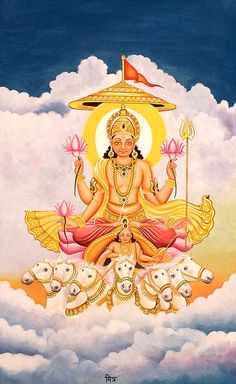
On the command of Lord Brahma, all Gods left to the heaven. But, it was not easy for Lord Brahma to ask Lord Shiva to leave Kashi and go to heaven as Kashi is believed to be one of the favourite places of Lord Shiva. So, when being pleased with the prayers of Bramha , Lord Shiva appeared in front of him , Lord Brahma told Lord Shiva that how King Divodas can save humanity and about King’s condition that all gods should leave to heaven. As Lord Shiva could not deny the request of Lord Brahma, so he also left to Mandaranchal from Kashi. As per his condition, King Divodas took the throne and worked vigorously to bring order in the decaying world. With the favours obtained from Lord Brahma, king established a rule so flawless that was never seen before. Under his regime, his subjects prospered and justice flourished.
As time passed, Lord Shiva desired to again come back to his own city Kashi. But due to Brahma’s boon to Divodasa, he was unable to set feet in Kashi. Soon Lord Shiva came to know that other gods too are unable to stay in Kashi. Not happy with this kind of attitude of the Divodas, Lord Shiva decided first to cast some dents into the flawlessness of Divodas’ rule in order to reduce his powers and then to end his regime. Accordingly, he sent sixty four Yoginis to create some disturbance, but they were enthralled by the beauty and serene surroundings of Kashi which appeared to be a part of heaven. They ultimately settled down there. When the Yoginis failed to return, Lord Shiva sent Lord Surya with instructions to create some disturbance in Kashi so as to defeat King Divodas in his resolve. Lord Surya came to Kashi and disguised himself as an astrologer, a learned scholar, a religious propagator, a businessman, a brahmin etc. But he could not find anyfault with any person in Kashi or with the governance of King Divodas. Lord Surya was also very much attracted towards Kashi and the beauty of the city. Lord Surya thought, if he went back to Mandarachal without fulfilling the wishes of Lord Shiva, the latter would get angry.
Lord Surya finally decided to stay in Kashi. He said to himself, disobeying the instructions of Lord Shiva is a sin, but by staying in Kashi and undertaking religious activities, such sins will easily get cleansed. Accordingly Surya settled down in Kashi for the time being. Lord Surya is worshipped in his twelve forms and Kashi Khandhas narrated the importance of the twelve Adityas as under : Arunaditya Draupadaditya, Gangaditya, Keshavaditya, Khakholakaditya, Lolarkaditya, Mayukhaditya, Saambaditya,Uttararkaditya, , Vimaladitya, Vriddhaditya, , Yamaditya
2.1 Arun Aditya
Arun Aditya Is located in the Trilochan Mahadev Temple. According to a legend described in Kashi Khand, Sage Kashyap had two wives Kadru and Vinta. Kadru gave birth to hundred snake sons and Vinta gave birth to three sons namely Ulook, Arun and Garuda. Other birds removed Ulook from the designation of Pakshiraj by stated him as “Nirgun”. This depressed Vinta . So, when she conceived for the second time, she attempted to break the shell of the egg in the premature level only with the wish to see her child. After breaking the premature shell, Arun took birth from it. Arun was perverted being prematurely born. His body above the thighs was fully developed but lower portion was not properly developed. Just after his birth as a prematurely delivered baby, Arun cursed his mother that one day she will become a slave of her sister Kadru. When Vinta requested for the freedom from the curse, Arun told his mother that if she will let her another egg develop properly then she will give birth to a son who will make her free from slavery. With these words, Arun flew to Kashi, established an idol of Lord Surya there and started performing penance. As a result, Suryadev manifested, blessed him with a number of boons and established himself there in form of Arun Aditya and also stating that the latter will always be with him (Lord Surya) as his charioteer. Lord Surya said a person who worships me in the form of Arun Aditya will not know what is sadness and poverty will always remain at a distance.
 |  |
According to Kashi Khand, a person who worships Arun Aditya will never fall ill and there will be noobstacles in the devotee’s smooth life. The devotee will not know what is misery
Temple remains open for worship from morning 5:00 A.M. to 12:00 noon and from 5:00 P.M. to 11:00 P.M. Aarti is performed here twice a day, once in morning at 5:30 A.M. (Mangal Aarti) and second at 11:00 P.M (Shayan Aarti). Pandit Girija Shankar Pandey is the Poojari of the temple his Cell number (0)9236511267
2.2 Draupad Aditya temple
Draupad Aditya temple is located near Visheshwar temple, Akshay Vat. According to a story described in Kashi Khand when the Pandavas faced difficulties owing to the rivalry with their siblings and became forest dwellers, then their wife reached Kashi and started performing penance and prayed Suryadev. Suryadev got pleased by prolonged penance of Draupdi and handed over a bowl to her with a boon that until Draupdi wouldn’t take meals from that bowl; it can satisfy the hunger of innumerable people. Since then, Suryadev is residing here in form of Draupad Aditya. As per the beliefs, the devotees who worship Draupad Aditya located at the southern side of Vishweshwar, never have to face hurdle related to hunger and they never have to face the grief of separation from their loved ones.
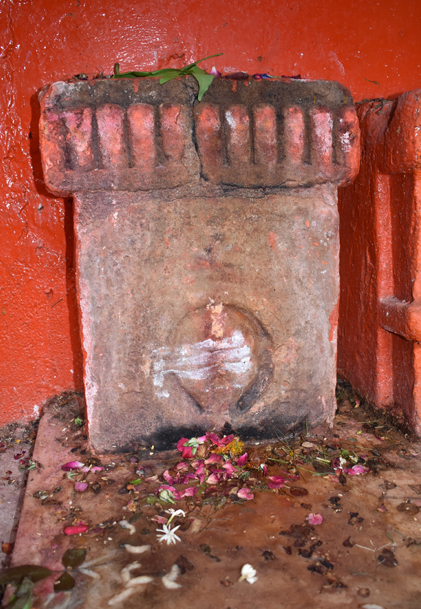
When Pandavas went in exile, Draupadi was extremely sad to look at the plight of her husbands. (It is wellknown that Draupadi was married to the five pandavas and she also accompanied them to the forests andother places in exile).
She came to Kashi and started intensely praying to Lord Surya. Lord Surya was deeply moved by hersincerity and appeared before her. He gave her one vessel and told her that the vessel would be a “neveremptying vessel” inasmuch as she could go on feeding any number of guests and the vessel would never getempty. However, she should be the last one to eat. (Even now old timers say that Guests should be fed firstand household ladies should be the last to eat).
Lord Surya also told Draupadi about a divine wish that Lord Shiva had given to him. According to it, if a devotee who comes to pray to Vishveshwar in Kashi, prays to Lord Surya first, Lord Surya will have thepower to remove all the sorrows which are clinging to the devotee. Lord Surya also states here that a personwho sincerely prays to him at this place will never remain hungry. (Kashi Khand, Chapter 49). Temple remains open for worship throughout the day
2.3 Ganga Aditya Temple
Ganga Aditya Temple is located at , below Nepali temple at Lalita Ghat.Varanasi, Uttar Pradesh . Varanasi has been home to numerous Surya-related temples. Predominantly lord Surya is worshipped in following twelve forms in Varanasi Arun Aditya, Drupad Aditya, Ganga Aditya, Keshava Aditya, Kakholkh Aditya, Lolark Aditya, Mayukh Aditya, Sambha Aditya Uttarark Aditya, Vimal Aditya, Vriddh Aditya & Yama Aditya. Probably only city in India where one can find such 12 Aditya Temples.
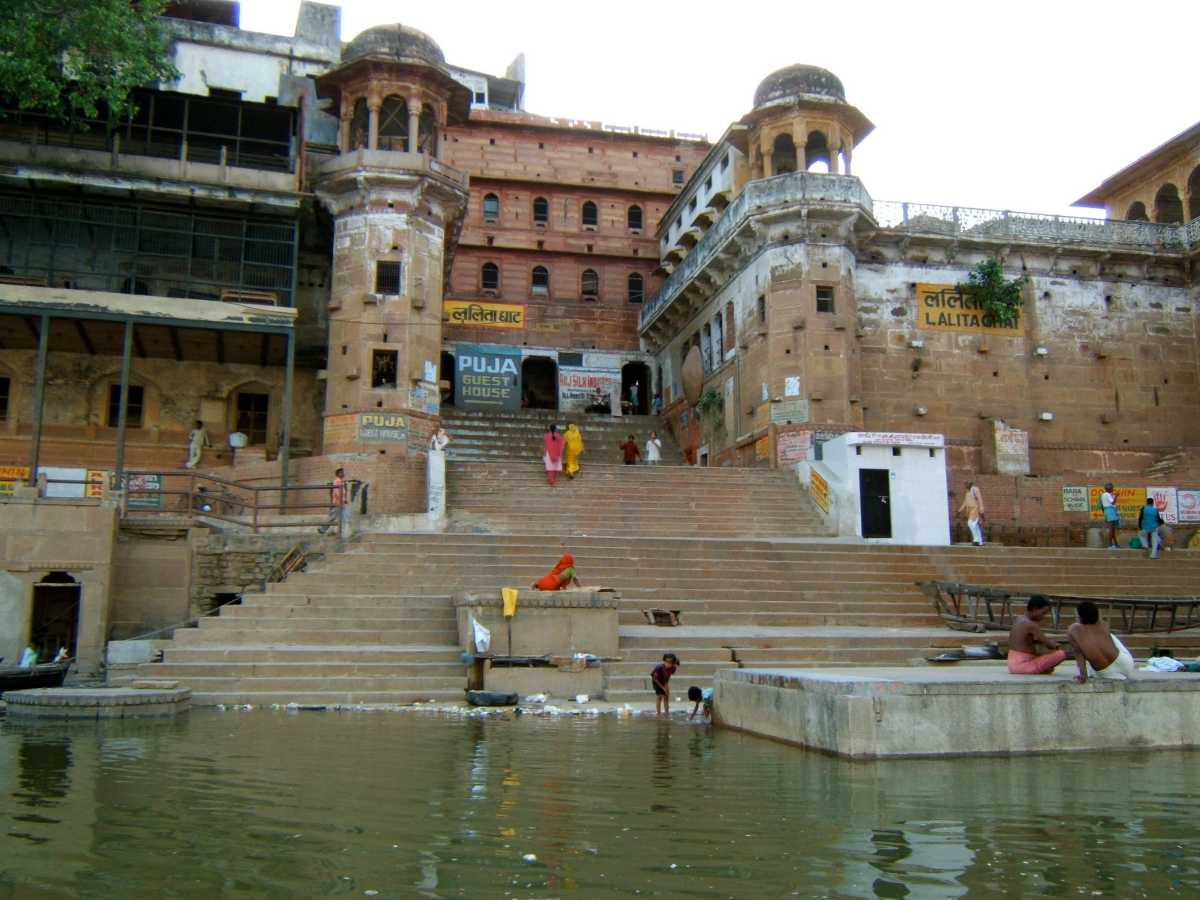 |  |
According to a story mentioned in Kashi Khand, when holy Ganga arrived in Varanasi, Suryadev reached there to praise Ganga. It is believed that since that day, he is established there and still praising Ganga. He is popularly known as Ganga Aditya here. According to beliefs, merely by darshan of Ganga Aditya, devotees can get rid of all their sins and diseases.
In ancient times, idol of Ganga Aditya was established at south of Agastya Kund along with idols of Ganga Keshav and Gangaji. But presently these three idols are established at Lalita Ghat.Temple remains open throughout the day for worshipping by devotees.
2.4 KESHAVADITYA MANDIR
KESHAVADITYA MANDIR is located at Aadi Keshav Temple, Raj Ghat Varanasi, Uttar Pradesh . According to a story mentioned in Kashi Khand, once Suryadev was travelling in the sky, he saw Lord Vishnu worshipping a Shiv Ling. In a curiosity to know that universally worshipped Lord Vishnu is worshipping whom, Lord Surya came down to the earth. Lord Surya asked when the entire world regards Lord Vishnu as Antaratma, why Lord Vishnu was worshipping Lord Shiva. To quell his anxiety, Lord Vishnu replied that in Kashi Kshetra Lord Shiva is the supreme Lord and he should be worshipped by every one and Shri Keshav has also got his splendor from Lord Shiva only. By worshipping Lord Shiva, sins of hundreds of births can be washed away. On hearing this from Shri Keshav, Suryadev started performing penance by worshipping Shivalinga by assuming Adikeshav as his Guru. Since then, Lord Aditya is established here and popularly known by the name of Keshav Aditya. It is believed that by worshipping Keshav Aditya, devotees can get rid of all their sins.
 | 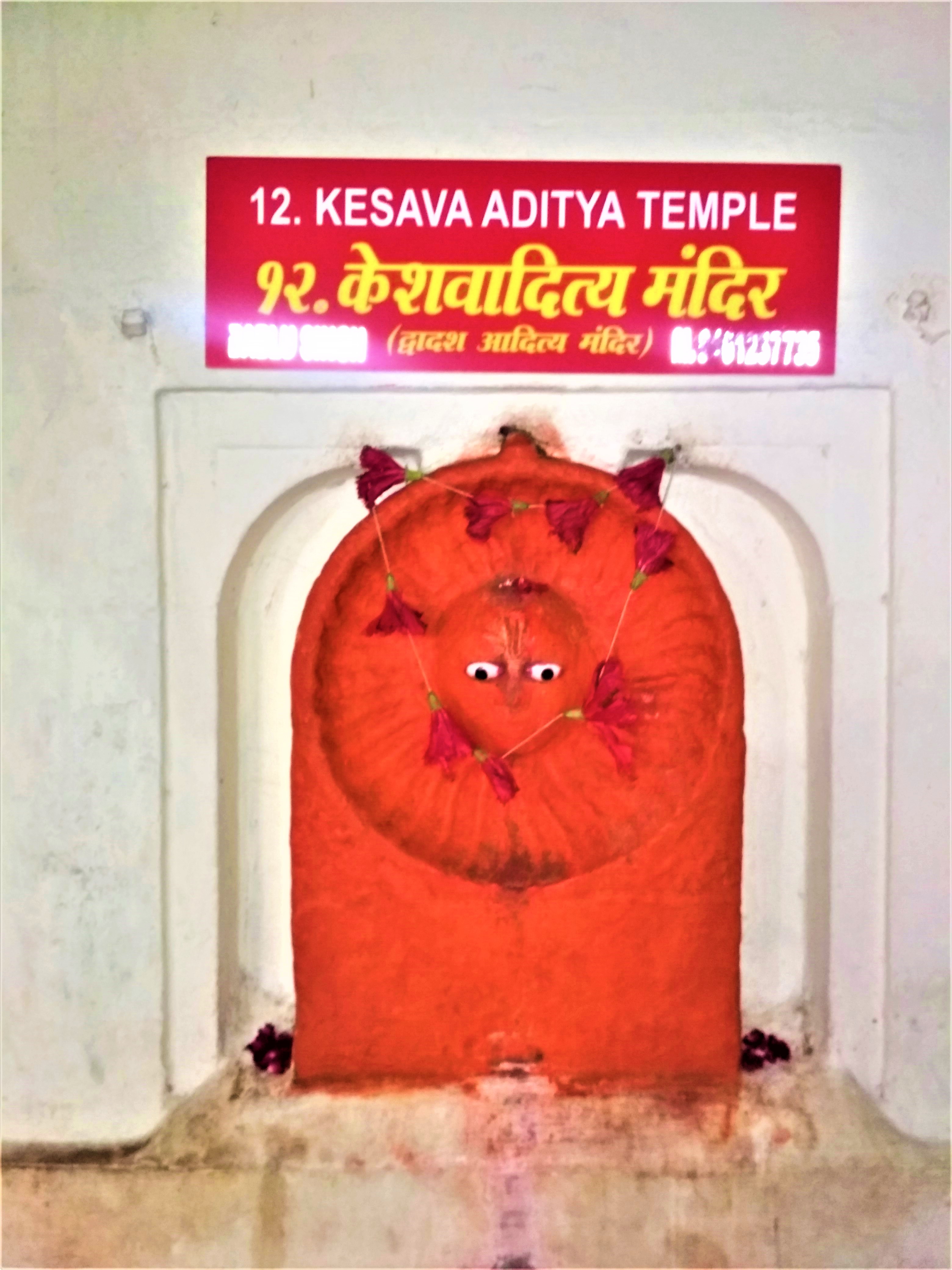 |
Temple remains open for worshipping by devotees from 6:00 A.M. till 12:00 noon and 4:00 P.M. to 10 P.M.
2.5 KHAKOLA ADITYA MANDIR
KHAKOLA ADITYA MANDIR is located inside Kameshwar Mahadev Temple, Macchhodari , Varanasi, Uttar Pradesh
Varanasi has been home to numerous Surya-related temples. Predominantly lord Surya is worshipped in following twelve forms in Varanasi Arun Aditya, Drupad Aditya, Ganga Aditya, Keshava Aditya, Kakholkh Aditya, Lolark Aditya, Mayukh Aditya, Sambha Aditya Uttarark Aditya, Vimal Aditya, Vriddh Aditya & Yama Aditya. Probably only city in India where one can find such 12 Aditya Temples
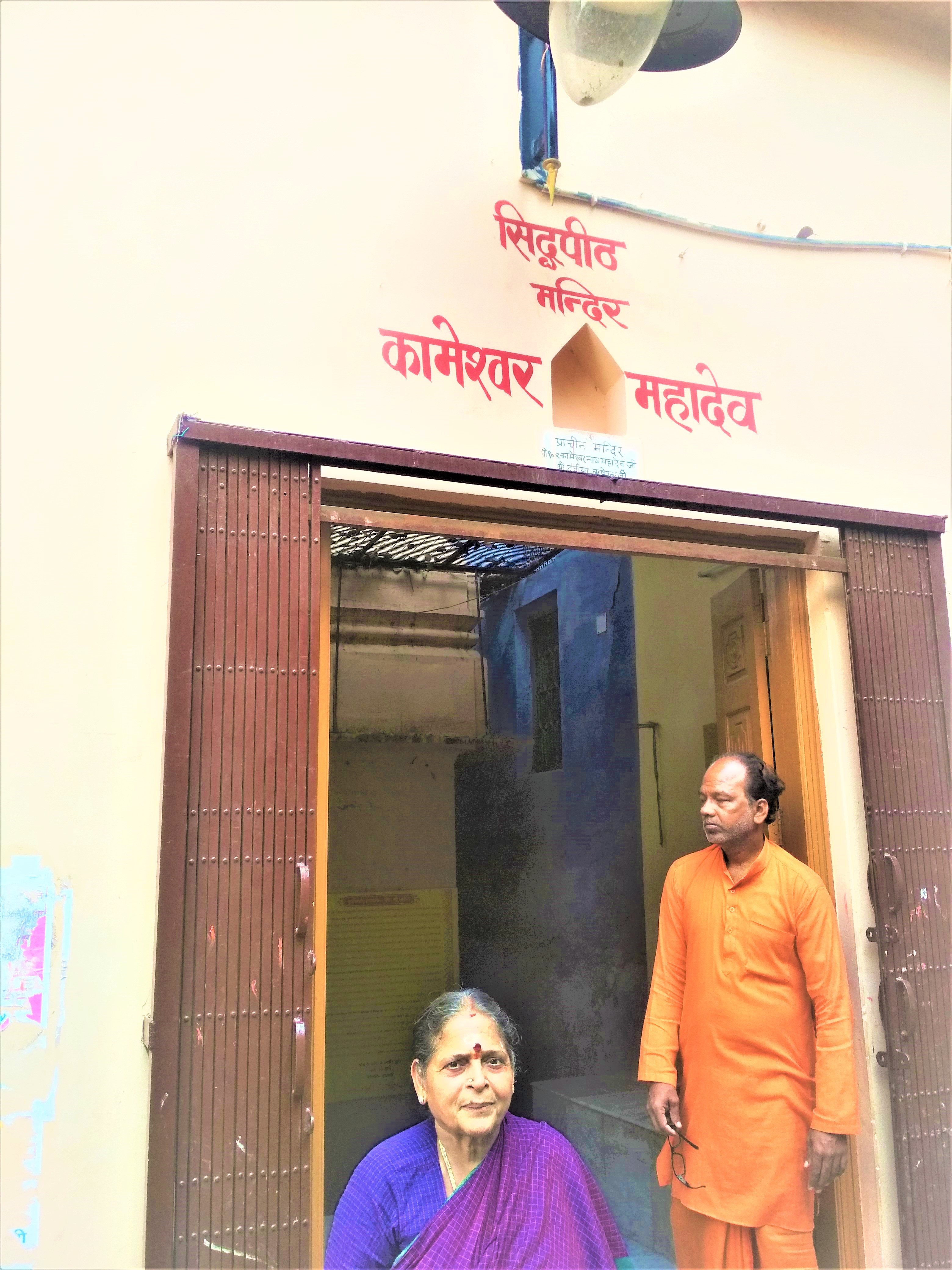 | 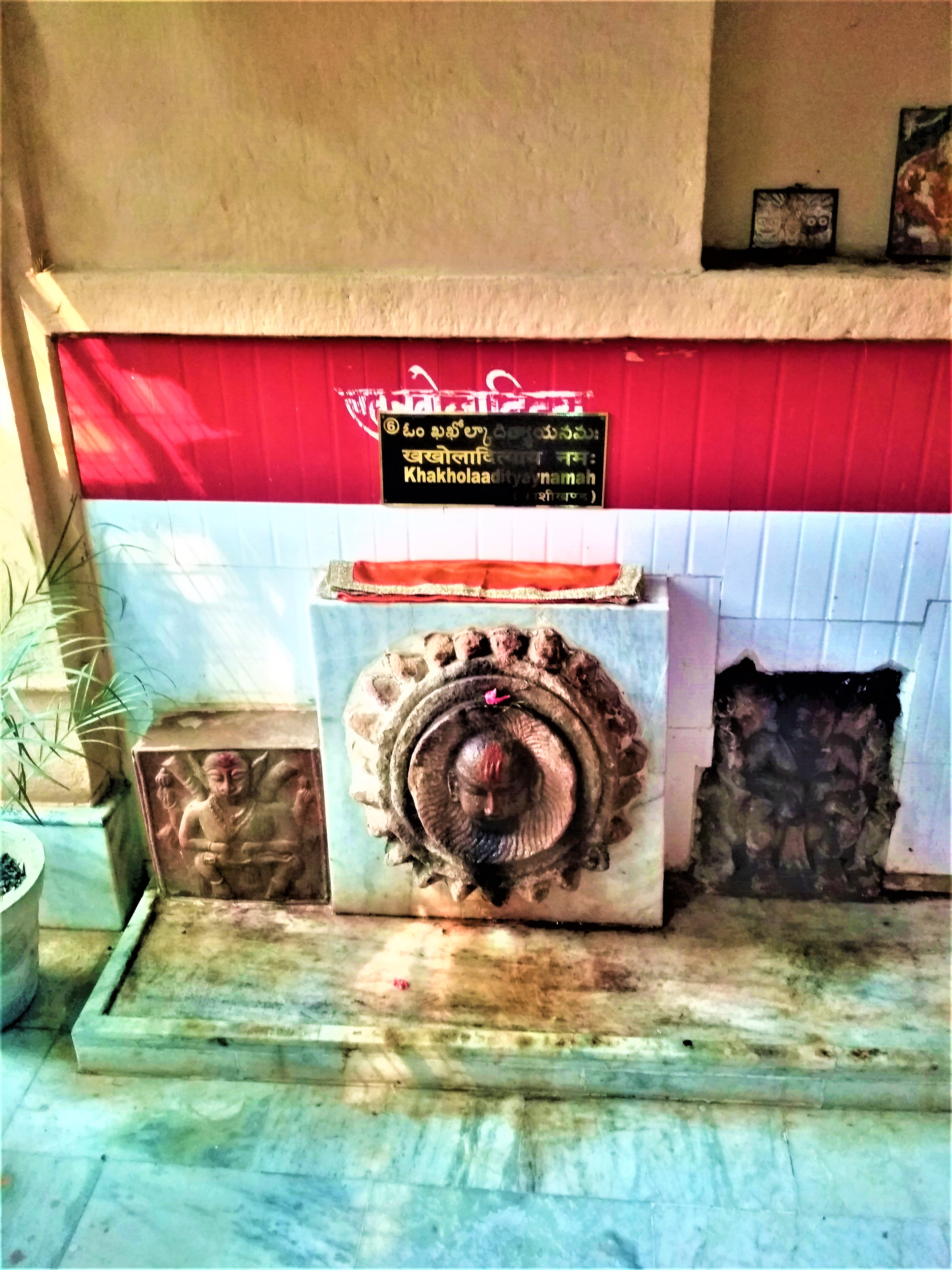 | 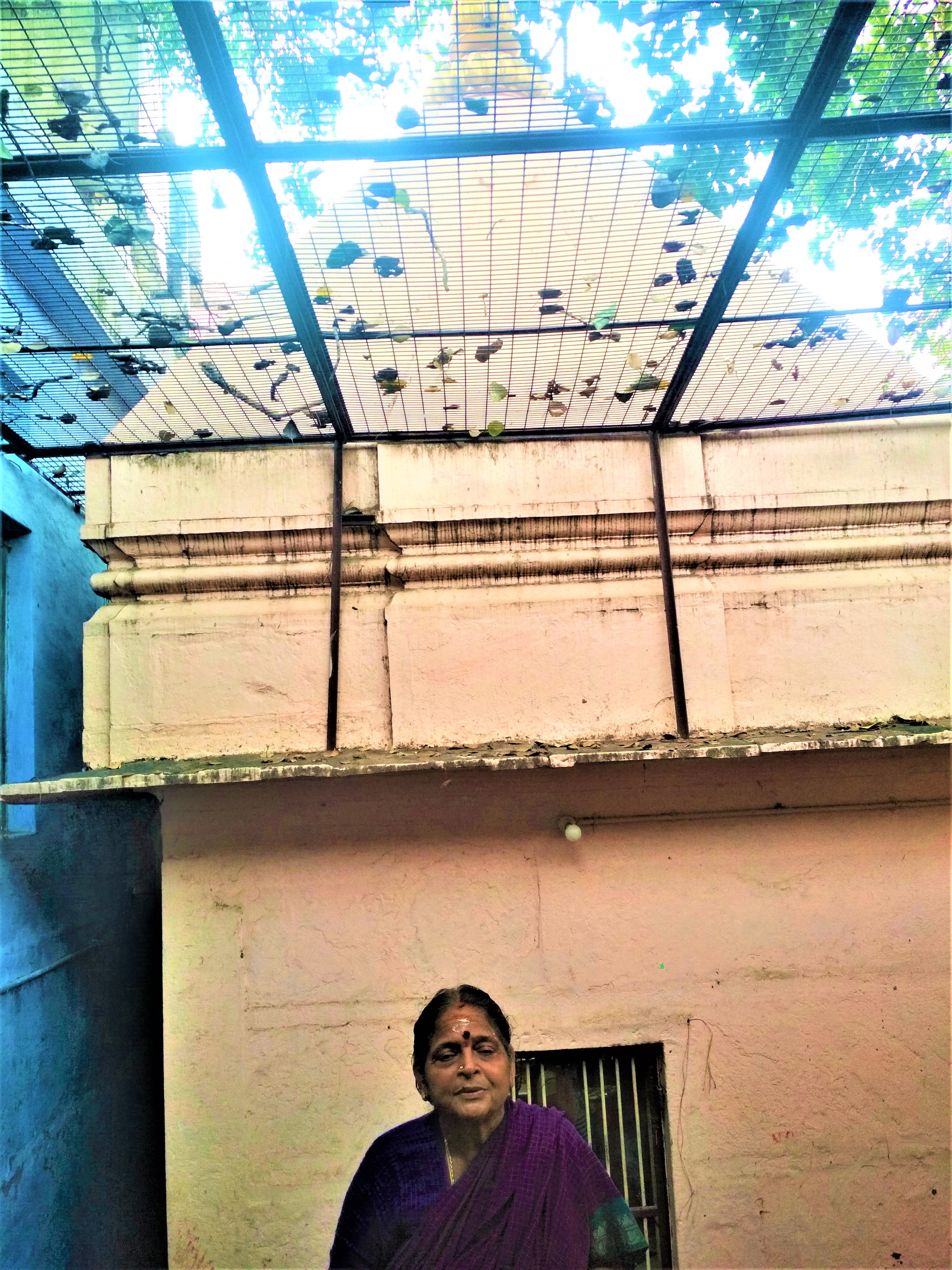 |
As per legend, in Kashi Khand, in ancient times, Dakshprajapati had two daughters namely Kadru and Vinta who were married to the son of Marichi Prajapati Kashyap. Once while playing they started conversing. Kadru asked Vinta that a horse who is part of the chariot of Suryadev is white or spotted? Kadru also put a bet that the loser will have to become the slave of the winner. Thus, Kadru said spotted and Vinta said white. Later Kadru ordered her snake sons to go to Ucchaishrava (the horse) and cover its tail while spitting poison so that the colour of the horse will appear spotted. Sons obeyed their mother. Thus, both Kadru and Vinta saw the Ucchaishrava as spotted while passing through the sky. As per the bet, Kadru won and Vinta has to become her slave. From that time onwards Vinta served Kadru and her sons which made her feel depressed all the time.
Garuda, the son of Vinta by seeing her mother sad asked her the reason. Then, he came to know that as Vinta is a slave of Kadru that is why she remains upset all the time. He told her mother to ask from Kadru’s son that at what cost, they will make her free from slavery. Vinta did so. Kadru’s snake sons replied that in the exchange of Nectar, they will free Vinta from slavery. So, Garuda went to heaven to approach gods for Nectar to get her mother free from slavery. Garuda displayed wisdom there and succeeded to get the Nectar. When Lord Vishnu came to know about this, he had a huge war with Garuda.
During battle, Lord Vishnu saw the valor of Garuda and asked him to seek a boon. In turn, Garuda asked Lord Vishnu to seek a boon. In reply Lord Vishnu asked for two boons from Garuda. First one was that Garuda should only show the nectar to snakes and make his mother free from slavery and ensure that snakes should not taste the nectar. Second one was that Garuda should return the nectar to gods safely after freeing her mother from slavery. Garuda reached to snakes, handed over the nectar to them and made her mother free from their slavery as mutually agreed earlier. Later when snakes tried to taste the nectar, Garuda told them that if anyone will touch the nectar without having a bath, it will be lost.
When snakes went for bath, Lord Vishnu took the nectar pot and left. When snakes returned they didn’t found the nectar there. Seeing this, with the wish to just taste a drop of the nectar snakes started licking Kushes, on which nectar pot was kept. In this process, they couldn’t get nectar but their tongues slitted into pieces.
When Vinta got freedom from slavery then she moved to Kashi for atonement of the sins that made her slave. She made an idol of Khakholak Aditya and was engrossed in a rigorous penance. Suryadev being pleased by her penance established himself there as a boon to her and became popular as Khakholak Aditya. As per beliefs, Khakholak Aditya removes the hurdles from the lives of his devotees. Those who worship Khakholak Aditya get rid of all kinds of sins.
Temple remains open for worship from 5:00 AM to 12.00 noon and from 5:00 PM to 10:00 PM. Mangala Aarti is held here at 5:30 AM and Shayan Aarti at 9:30 PM . Contact : Shri Rajesh Giri, poojari, Mob: 9839703054 ;
2.6 LOLARK ADITYA MANDIR
LOLARK ADITYA MANDIR is situated in the southern part of Kashi near Assi-Ganga Sangam, near Lolark Kund , Tulsi Ghat, Varanasi, Uttar Pradesh..A person who religiously prays to Lolark Aditya on every Sunday is absolved of all his sins and all his skinailments will be healed. (Kashi Khand, Chapter 46).

LolarkKund has been given great importance in Kashi Khand. In ancient times, Lolark Kund was believed to be inconfluence with Ganga and Assi a rivulet but now this is in form of a Kund (Pond) only. Even now, duringrainy days, Ganges water enters the Kund through some underground source.
Great importance is attached to taking bath in this Pond in Magha Month when Shukla Shashti or Saptmi(sixth or seventh day after Amavasya) coincides with Sunday. Bathing on such a day in this kund andperforming puja etc. will grant the devotees all their desires. The devotee’s sins accumulated over sevenprevious births will be cleansed away by the above religious act. (Kashi Khand, Chapter 46).
Lolark Aditya is situated on Lolark Kund near Asi Ganga Sangam in Varanasi. Lolark Kund has been given great importance in Kashi. Lolark Aditya have been categorized as one of the most beautiful locations of Varanasi and it is believed that they take care of the welfare of natives of Kashi. Being on Asi Sangam where the water of Lolark Kund meets with the water of River Ganges and then reaches to other pilgrimages in Varanasi, it has been considered as one of the prominent pilgrimage in Varanasi.
As per legend in Kashi Khand, Lord Shiva ordered Suryadev to move to Kashi and cast some dents into the flawlessness of Divodas’ rule in order to reduce his powers and evict off the religious King Divodas. Suryadev obeyed Lord Shiva’s orders and proceeded to Kashi.
On reaching Kashi, Suryadev got excited to explore the city that gives salvation. Later, Suryadev carried out internal and external checks in the city but could not find any unrighteousness against the king. Finally, Suryadev decided not to return to Mandarachal and got himself established in Kashi in the form of his twelve idols. Because Lord Aditya got mesmerized with the beauty of Kashi, thus he was called as Lolark here.
It is believed that if someone go for annual visit to Lolark on Sunday of Agahan month then he can get rid off all his sins. The devotee who takes a dip at Asi Sangam, and offers Shradh of their forefathers, he is freed from Pitra-Rin. On Shukla Saptami of January-February, if a person takes holy dip in the confluence of River Ganges and Asi, in the Lolark Kund, he is freed from all his sins of his seven births.
This temple remains open throughout the day for worshipping. Darshan-Poojan in this temple on Sundays holds special significance. Presently, on a particular day every year (Lolark Chat) which falls in the Bhadrapad Month Shukla Paksha Shashti (6th day after Amavasya) devotees come in large numbers for taking bath inLolark Kund. Further, Margashirsha Month, Shukla Paksha Shashti (6th day after Amavasya), is also an important day.
2.7 Mayukh Aditya
Mangla Gauri Temple houses Mayukh Aditya temple near Panchganga ghat;
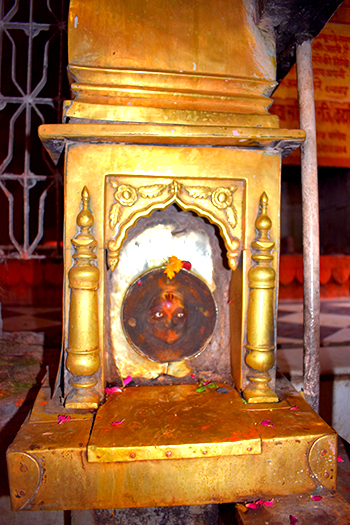
As per legend, Once Lord Surya installed a Shiv Ling known as Gabhasteeshwar and a devi idol known as Mangala Gauri at Panchanada Teerth (Panchganga Ghat) and started immensely praying to Lord Shiva. After 1 lakh years of his tough penance, Lord Shiva and Goddess Parvati appeared in front of him .The intensity of Lord Surya’s prayers started reflecting in the extreme heat generated thereby. Sun rays started getting warmer and warmer. Finally it became extremely unbearable for all living beings and all physical activities practically came to a standstill.
Lord Shiva and Goddess Parvaty appeared in front of Lord Surya. Lord Shiva gently touched Lord Surya, whereupon the latter’s extreme heat slowly subsided and he became more or less cool. Lord Surya opened his eyes and started singing praises of Goddess Parvaty and Lord Shiva whereupon both of them became extremely happy. Lord Shiva pleased with his penance asked him to seek a boon. They granted several divine wishes to Lord Surya and since then Suryadev is established here and is popularly known as Mayukh Aditya. As per beliefs, devotees are freed from all sorts of diseases if they worship Mayukh Aditya and if they worship on Sundays, they does not have to face poverty in their lives.
Lord Shiva told Lord Surya that when the latter was performing pooja of the former, only the sunrays were visible and the body of Lord Surya was not visible. Accordingly, Lord Surya will be called Mayukh Aditya. Mayukh means effulgence. Lord Shiva also stated that a devotee who worships Mayukh Aditya on Sundays will never fall ill. (Kashi Khand, Chapter 49).
The idol of Mayukh Aditya always remains moist and cool. If we physically remove the moisture and makeit dry, the idol will again become moist. The reason for this is Lord Shiva touched Lord Surya to reduce hisintense heat (as mentioned above). Old timers in and around the temple believe that the hidden river Dhootpapa is flowing beneath the surface, causing this moistness.
The temple also houses Gabhastheeshwar, Mangala Gauri and Mangal Vinayak. In the close vicinity aretemples of Brahmacharini and Brahmeshwar.
The temple is open from 05.00 a.m. to 01.00 p.m. and from 03.00 p.m. to 10 p.m. Aarties are performed in the evening. Shri Manoj Kumar Pandey is the chief priest and his cell number is (0)9305645502. Other priest is Shri Umesh Kumar Sharma whose cell number is (0)9450284728.
2.8 Samba Aditya Temple
Samba Aditya Temple is located at Surya Kund , Sidhgiribagh, Varanasi, Uttar Pradesh. Varanasi has been home to numerous Surya-related temples. Predominantly lord Surya is worshipped in following twelve forms in Varanasi Arun Aditya, Drupad Aditya, Ganga Aditya, Keshava Aditya, Kakholkh Aditya, Lolark Aditya, Mayukh Aditya, Sambha Aditya Uttarark Aditya, Vimal Aditya, Vriddh Aditya & Yama Aditya. Probably only city in India where one can find such 12 Aditya Temples.
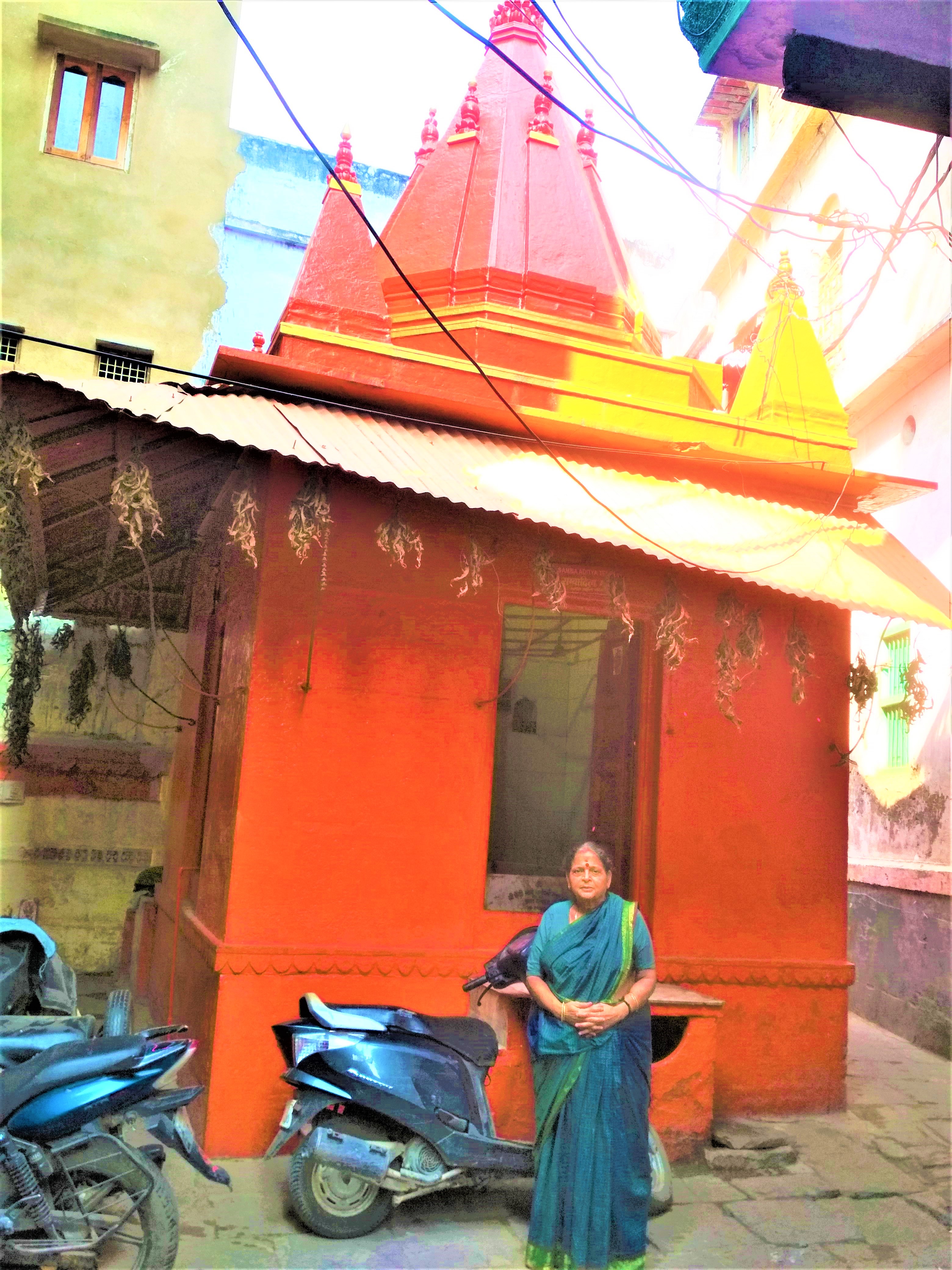 |  |  |
As per legend, Once Sage Narada traveled to Dwaraka Puri and he was fondly welcomed by themind born sons of Lord Krishna. They exhibited hospitality of the highest order and Narad was pleased. But, Saamb who was egoistic about his looks, did not respected Narad Muni and ridiculed him Lord Krishna welcomed Sage Narad in the former’s palace with all humility. After exchanging allformalities/pleasantries, Sage Narad brought Saamba’s behaviour to the notice of Lord Krishna .
After departure of Narad Muni, Lord Krishna kept a deep day-night observation over Saamb but no faults could be revealed. However, the surveillance went on for quite some time.
After some days, Narad again visited Dwarka Puri and precisely at that time, Lord Krishna was in hispersonal chambers alongwith various ladies. Narad called Saamba, who was loitering outside, and told him to inform Lord Krishna about his arrival. Saamba hesitated for a while. It was a double whammy for him. On the one hand, if he barges in and disturbs Lord Krishna, the latter may get angry. On the other hand, if he disobeys Narad, he may get angry because on the earlier occasion he had not respected Narad. As soon as Saamb entered in the private suite of Lord Krishna, Narad Muni followed him to the room. Lord Krishna suddenly got up very embarrassed. All the girls surrounding him were also equally embarrassed. Saamba silently left the place.
Narad gave a wrong interpretation of the events to Lord Krishna that due to charm of Saamb, all women present there were attracted to him.
Hearing this, Lord Krishna became angry and cursed Saamb with leprosy. But when he came to know that Saamb was innocent, he suggested him to proceed to Kashi and perform penance while establishing an idol of Suryadev to get rid of the curse. Accordingly, Saamb proceeded to Kashi, made a Kund there and started penancing Suryadev and In due course, he was cured of this dreaded disease. Since then, Suryadev is residing here came to be called as Saamb Aditya. As per the beliefs, worshipping Saamb Aditya on Sundays is a key to get relief from all kinds of incurable diseases.
According to Kashi Khand Chapter 48, a person who takes bath in Saamba Kund religiously on Sundays atsunrise and prays to Saamba Aditya will get cured of any incurable disease, any married lady performingsuch prayers will always remain Sumangali (Suhagin-lady whose husband is alive) and childless couple willbe blessed with child. Saamba Kund is now known as Surya Kund / Suraj Kund. Temple remains open for worshipping from 6:30 AM till 01:00 PM and 07:00 P.M. to 9:00 P.M.
2.9 Uttarark Aditya, – Uttar Surya Narayan Temple
Uttar Surya Narayan Temple is located at Bakaria Kund, Jaitpura, Varanasi, Uttar Pradesh. Varanasi has been home to numerous Surya-related temples. Predominantly lord Surya is worshipped in following twelve forms in Varanasi Arun Aditya, Drupad Aditya, Ganga Aditya, Keshava Aditya, Kakholkh Aditya, Lolark Aditya, Mayukh Aditya, Sambha Aditya Uttarark Aditya, Vimal Aditya, Vriddh Aditya & Yama Aditya. Probably only city in India where one can find such 12 Aditya Temples.
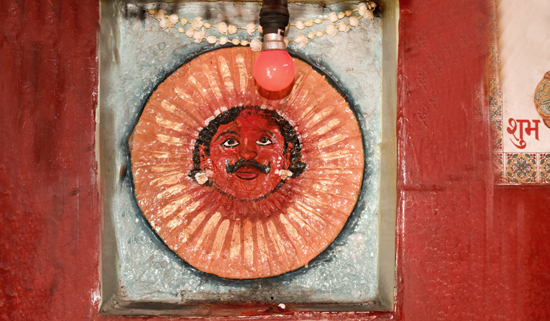
As per legend, in Kashi Khand, Suryadev is established as Uttarark Aditya at Ark Kund in the north of Kashi. Presently, this Kund is known as Bakaria Kund. According to Kashi Khand, Chapter 47, long time back, one Brahmin named Priyavrat was living in Kashialongwith his beautiful wife named Shubhavradha. Both were very religious and were blessed with abeautiful girl child, who was named as Sulakshana. The girl was born in Moola Star, 1st Charan (Padam)with Guru in fourth house. This combination is not supposed to be auspicious.
The child grew up to be a beautiful girl, well versed in all household activities. When she approached the ageof marriage, her father got worried because he had to find a suitable match for her, mainly because of herbirth in Moola star. Due to constant worries he fell sick and as there was no cure for worries, he died in duecourse. Overcome with grief, the girl’s mother also died, leaving the girl all alone in the world.
The girl dutifully performed the rites of her parents and she started praying to Lord Surya in his form ofUttarark Aditya. She underwent severe penance for a considerably long time and observed that a white goatused to come daily and constantly stare at her. The goat used to take bath in the Kund in the morning, wait for the whole day and in the evening, it used to eat dry grass, drink water from the Uttarark Kund and go back. This went on for several years.
Lord Shiva and Goddess Parvaty were deeply moved by the prayers ofSulakshana and Lord Shiva offered the girl a divine wish.Sulakshana thought for a moment and saw the Goat standing nearby. She requested Lord Shiva to grant a boon to the Goat instead of herself. Goddess Parvaty was moved by the philanthropy exhibited by Sulakshana and ordained that Sulakshana will always be with Goddess Parvaty as a companion. The goatwill take rebirth as daughter of Kashi Raja in consideration of its devotion to Uttarark Kund.
According to Kashi Khand, Goddess Parvaty stated that the Kund will be remembered for the sincerity of the Goat (because the Goat was regularly taking bath in the Kund even during severe winter months) and that alldevotees should take bath in the above Kund in Paushya Month (December-January) on Sundays and pray toUttarark Aditya. By performing the above ritual, they will be divinely blessed. The Kund is now known as Bakria Kund in local parlance.
As per beliefs, he resolves all the problems of his devotees, add supreme joy and always act as a saviour of Kashi. Any devotee who worships Uttarark Aditya, she/he is freed from all kinds of fears and inequality.
The temple remains open for worship from from 05:00 AM till 12:00 at noon and again from 05:00 PM till 10:00 PM at night. Aarti is performed here at 08:00 AM daily. Shri Ashok Tripathi is the poojari of the temple and he can be contacted in his Cell No.(0)9305041589
2.10 Vimala Aditya
Vimala Aditya temple is located at Jangambari, Ramapura Varanasi, Uttar Pradesh .According to Kashi Khand, a mere darshan of Vimal Aditya is capable enough to cure all kinds of diseases.
Varanasi has been home to numerous Surya-related temples. Predominantly lord Surya is worshipped in following twelve forms in Varanasi Arun Aditya, Drupad Aditya, Ganga Aditya, Keshava Aditya, Kakholkh Aditya, Lolark Aditya, Mayukh Aditya, Sambha Aditya Uttarark Aditya, Vimal Aditya, Vriddh Aditya & Yama Aditya. Probably only city in India where one can find such 12 Aditya Temples.
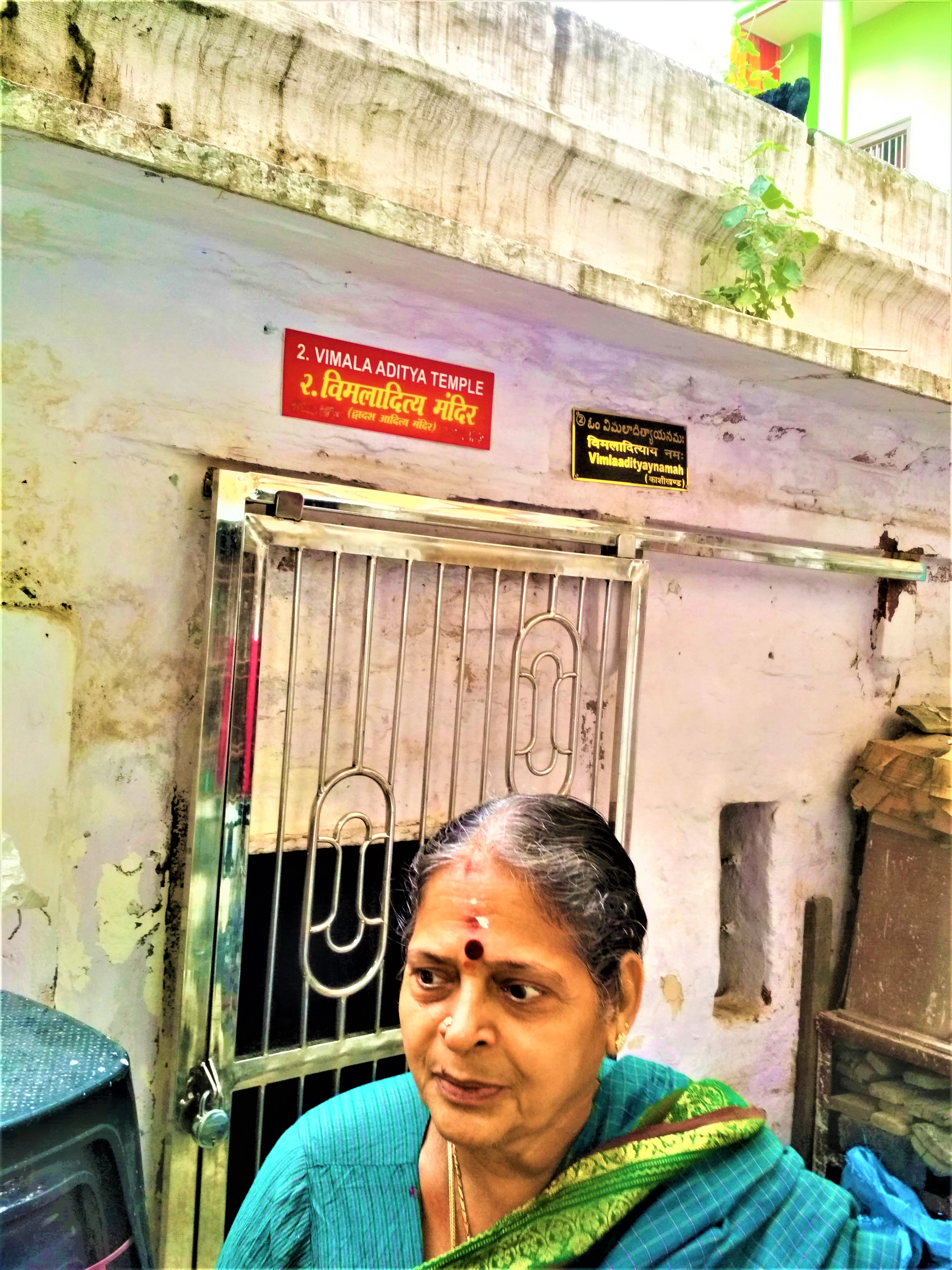 |  |
As per legend, Long time back, one person named Vimal was residing in a hilly place. Due to some sins committed in his earlier life, he was afflicted with Leprosy. He had heard about Kashi and So, he left his home, family, wealth etc and came to Kashi and started worshipping Lord Surya with all fervour.
He performed all sorts of Poojas, Pushp Archana and other rituals as are prescribed for Lord Surya. His pious actions pleased Lord Surya who appeared before him and with his divine blessings, Vimal was cured of his ailment (Leprosy). Lord Surya also offered a divine wish to Vimal.
Vimal appealed to Lord Surya that all his devotees should never be afflicted by this dreaded disease. They should not face any sort of difficulties in their life. Lord Surya granted accordingly and stated that devotees will know him as Vimal Aditya at that place. Further, Lord Surya will always remain in the idol of Vimal Aditya and will continue to bless his devotees. The place of worship remains practially open throughout the day.
2.11 Vruddha Aditya Temple
Vruddha Aditya Temple is located at Meer ghat, Lahori Tola, Varanasi, Uttar Pradesh. As per legend, in Kashi Khand, once a staunch devotee called “Vriddhharit” who was very old in age, Once he established an idol of Suryadev at southern side of Vishalakshi Devi and started performing a severe penance devotionally. and intensely prayed to Lord Surya. Being pleased with his prayers Suryadev manifested before him and gave him a boon of Soundaryrapunj Taran ( youth)as wished by the Brahmin and established himself there
 | 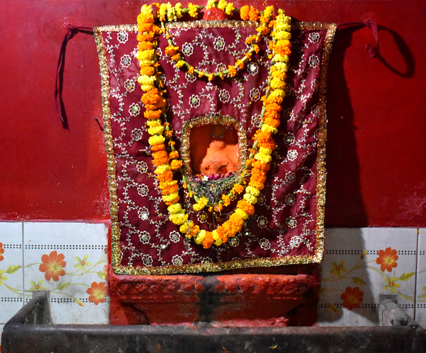 |
The old man said “for performing Tap (Tapas – rigorous ascetic practices), a devotee needs sufficient strength. There is nothing in this world as good as Tapas which gives prosperity, enlightenment and all joys. However, one needs to be young and virile enough for carrying out Tapas.” Accordingly, the old manrequested Lord Surya that he should be made young. .Since then he is popularly known as Vriddh Aditya here. As per beliefs, by worshipping Vriddh Aditya, devotees can attain siddhi and get relieved from all sorts of diseases.
Lord Surya was deeply movedby the sincerity and devotion of the old man and he granted boon accordingly.Thus the old man became young. Since Lord Surya was eulogized by an old man at that place, the Lordc ame to be known as Vriddh Aditya at that place. According to Kashi Khand, a person who regularly praysto Vriddh Aditya will always remain energetic like a young man.
The temple is open for worship from 06.30 a.m. to 09.30 p.m. The timings may change. While the idol issituated inside the premises, there is a Surya Chakra in the outer wall of the premises. Devotees canpray/perform pooja on their own.
2.12 Yama Aditya Temple
Yama Aditya temple is located at CK-7/135, on the stairs going towards Sankatha Ghat. As per legend, in Kashi Khand, in ancient times Yamraj established Yameshwar “Shivlinga” and an idol of Suryadev namely “Yama Aditya” at Yamghat and started worshipping it. As per beliefs, if devotees worship Yama Aditya after having a dip in Yamteerth, they don’t have to face the Yam (death). Simultaneously, if a devotee performs Pind daan in Yamteerth on Tuesday and on Bharni Nakshatrayukta Chaturdashi, she/he can be freed from Pitra Rin. Temple remains open for worshipping by devotees all the day.
To return to INDEX, Click Here. Otherwise Continue
3.0 Kashi Vishnu Yatra
According to a legend mentioned in Kashi Khand when during Padma Kalp there was a severe drought all across the world, then all creatures were severly afflicted by it. So, when Lord Brahma came to know about this he became worried as it was difficult for him to see his creation being on the verge of destruction. After a long search for a solution, Lord Brahma saw King Ripunjay who was dedicatedly engrossed in the penance. Being pleased by him, Lord Brahma renamed him to King Divodas and requested him to take the world under his throne and save the humanity. King agreed with this but he had one condition that he wanted to rule peacefully without intervention, so that he could reform the dharma without any disturbance. Therefore, he wished that all Gods and Godly entities should remain in the heaven only and should not return to land. Lord Brahma also kept a condition that King should be an excellent administrator and that every person staying in his kingdom or visiting his kingdom should be treated well with proper religious pursuits. King agreed.
On the command of Lord Brahma, all Gods left to the heaven. But, it was not easy for Lord Brahma to ask Lord Shiva to leave Kashi and go to heaven as Kashi is believed to be one of the favorite places of Lord Shiva. So, when Lord Shiva appeared in front of Madaranchal being pleased with his prayers and Mandaranchal asked Lord Shiva to reside upon him along with Goddess Parvati and his family as a boon, finding right time to aware Lord Shiva about King Divodas’ condition, Lord Brahma told how King Divodas can save humanity and about King’s condition that all gods should leave to heaven. As Lord Shiva could not deny the request of Lord Brahma, so he also left to Mandaranchal from Kashi. As per his condition, King Divodas took the throne and worked vigorously to bring order in the decaying world. With the favours obtained from Lord Brahma, king established a rule so flawless that was never seen before. Under his regime, his subjects prospered and justice flourished.
As the time passed, Lord Shiva desired to again come back to his own city Kashi. But due to Brahma’s boon to Divodas, he was unable to set feet in Kashi. Soon Lord Shiva came to know that other gods too are unable to stay in Kashi. Not happy with this kind of attitude of the Divodas, Lord Shiva decided first to cast some dents into the flawlessness of Divodas’ rule in order to reduce his powers and then to end his regime. For this purpose, Lord Shiva sent Yoginis and various gods to Kashi. But when Suryadev and Yoginis were failed to find out the loop holes in the kingdom of Raja Divodas and Lord Ganesha too got delayed in doing so, then Lord Shiva requested Lord Vishnu to go to Kashi and evict the King from his throne. Thereafter, Lord Vishnu left for Kashi and established himself as an idol on Ganga-Varuna Sangam near Padodak Teerth in the form of Adi-Keshav and left towards the North Direction of Kashi and reached Dharm Kshetra along with Goddess Laxmi and Garun. As they all reached there, Lord Vishnu transformed himself into fascinating Buddha saint,Goddess Laxmi into wanderer (Pravrajika) and Garud into a wise Buddha Pupil. After transforming themselves, they all started misleading and misguiding the citizens of Divodas’ Kingdom. As a result, they all succeeded in misleading the civilians of Kingdom. Pravrajika (transformed form of Goddess Laxmi) spread the profanity and misconduct across the city. In this way King Divodas got depressed and worried about his kingdom and citizens. Meanwhile, Lord Vishweshwar Dhundhiraj succeeded in controlling citizen of king’ kingdom with his Maaya Jaal. After getting downhearted, when king Divodas got to know that after 18 days a Audichya Brahmin is arriving in the city the King got excited. After 18 days Lord Vishnu himself arrived in the city of Divodas in the form of Brahmin. King Divodas welcomed the Brahmin with hospitality and asked him for the solution of his problem. In reply Lord Vishnu appreciated the qualities, good deeds etc. of King and his tenacity. Then Lord Vishnu told Divodas that he has committed a big mistake by dislodging Lord Vishweshwar from the Kashi, which has resulted the occurrence of such situation. He asked Divodas to establish a Shivalinga in Kashi if he wants a solution. Along with this, he also told the King that after seven days from establishing the Shivalinga, Viman of Lord Shiva will come and take him to the heaven (Swarglok). When all things got sorted Lord Vishnu established himself at Panchnad Teerth in Kashi to bless his devotees.
In Kashi, Lord Vishnu is established in eighteen forms. All these forms of Lord Vishnu are included in Kashi Vishnu Yatra. Following are the names of the forms of Vishnu in which he is established in Kashi:- Shri Bindu Madhav , Shri Adi Keshav, Shri Narad Keshav, Shri Prahlad Keshav, Shri Yagya Varah, Shri Vidar Narsimha, Shri Gopi Govind, Shri Hayagreeva Keshav, Shri Shwet Madhav, Shri Prayag Madhav,Shri Ganga Keshav, Shri Vaikunth Madhav, Shri Prachand Narsimha, Shri Atyugra Narsimha, Shri Kolahal Narsimha, Shri Vitank Narsimha, Shri Kokavarah, Shri Dharanivarah.
3.1 Sansthan Bindumadhav Devsthan
Sansthan Bindumadhav Devsthan is located at Panch Ganga Ghat, Varanasi, Uttar Pradesh. As per legend, As per directions of Lord Shiva, Lord Vishnu travelled from Mandarachal to Kashi with a divine mission of making King Divodas leave Kashi. After having accomplished his mission, Lord Vishnu was enjoying the serene beauty of Kashi, Pancha NadaTeerth, Padodak Teerth and other places. At Pancha Nada Teerth, he came across one extremely lean looking Sage who was undergoing Tapas.
 |  |  |
Lord Vishnu in his divine form approached the Sage whose name was Agni Bindu . The Sage, on seeing the Lord in person, was ecstatic and he prostrated before the Lord. and started singing in praise of the Lord. The Sage addressed the Lord by various names like Mukunda, Madusudan, Madhav, Narayan, Rama Bhadran, Chatur Bhuj, Janardhan etc.
Pleased Lord Vishnu asked the Sage to seek any divine boon. The Sage, in reply, sought that Lord Vishnu should always be available in the vicinity of Pancha Nada Teerth in the name of the Sage. Lord Vishnu granted accordingly. Lord Vishnu further told that he would stay in Kashi as long as Kashi is present and there will be no destruction of Kashi, as this holy city is situated atop the Trishul(Trident) of Lord Shiva. Therefore, even Maha Pralay (great deluge) cannot destroy the city.
Further, a devotee who takes bath in Pancha Nada Teerth and even if he dies elsewhere, he should attain Moksha. The Sage also sought that a devotee who bathes in Pacha Nada Teerth and worships Lord Vishnu should be blessed with wealth and prosperity.
Lord Vishnu agreed to the request of the Sage. He stated that henceforth he (Lord) will be known as Bindu Madhav in Pancha Nada Teerth. By his presence, the Teerth will be extremely Sacred and devotees who bathe in this Teerth and honour learned persons, will be blessed with wealth and prosperity.
The Teerth, which is capable of cleansing all Sins, will be called as Bindu Teerth. A person may have committed various sins, knowingly or unknowingly. But if, during the Kartik Month, he religiously bathes in Pancha Nada Teerth and worships Bindu Madhav, he will attain Mukti
Kashi Khand, Chapter 60 has given in detail the importance of Kartik Month in respect to Pancha NadaTeerth. Lord Visweshwar himself regularly takes bath in this Teerth during Kartik Month. Lord Vishnu further stated that he (Lord) was called as Aadi Madhav in Sat Yug, he should be worshipped as Ananda Madhav in Tretha Yug, he would present himself in Dwapar Yug as Shree Madhav. In Kali Yug the Lord should be known by the name of Bindu Madhav.
The temple remains open from 04.00 a.m. to 08.00 p.m. Mangala Aarti is held at 04.00 a.m., Shringar Aartiat 08.00 a.m. and Shayan Aarti at 08.00 p.m..Shri Murlidhar Ganesh Patwardhan is the poojary of the temple – his Cell No.(0)9918936350
Bindu Madhav temple also houses 108 Shiv lingas.
3.2 Shree Laxmi Narayan Mandir
Shree Laxmi Narayan Mandir is located at Panch Ganga Ghat, Varanasi, Uttar Pradesh.

It is the rather inconspicuous-looking temple which nevertheless attracts devotees in large numbers. Established in 1475 CE and renovated in 1975, this temple is dedicated to Lord Vishnu and his consort Goddess Laxmi. Offering visitors elevated views of the holy River Ganges and of the charming boats below, a visit is surely in order. The best way to reach here is by walking along the ghats and taking turn at Panchganga Ghat.
Shree Laxmi Narayan Mandir is located very near to the famous Bindumadhav Mandir. Must have darshan of both the temples.
3.3 Sri Adhi Kesava Perumal Temple
Sri Adhi Kesava Perumal Temple ( Also Hari Keshav Aditya, Gyan Keshav, Gnaneswar, & Chinta Haran Ganesh temples) Sri Adhi Kesava Perumal Temple is located at Adi Keshav Ghat. Varanasi, Uttar Pradesh. The temple also houses Hari Keshav Aditya, Gyan Keshav, Gnaneswar, & Chinta Haran Ganesh temples. Sri Adhi Kesava Perumal Temple is an imporetant Vishnu temple to be visited in Varanasi. which is part of Kashi Vishnu Yatra covering 18 Vishnu temples.
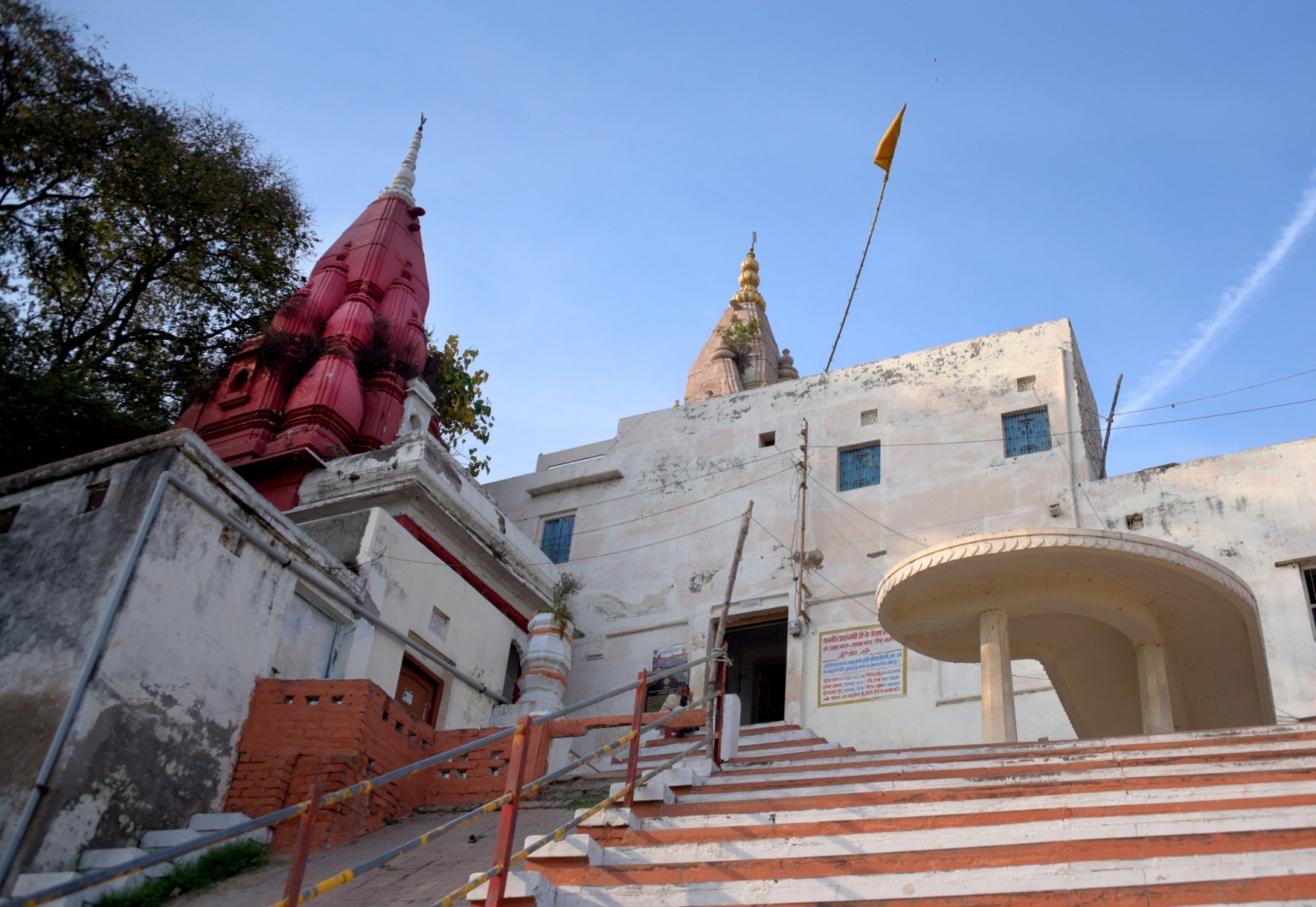 | 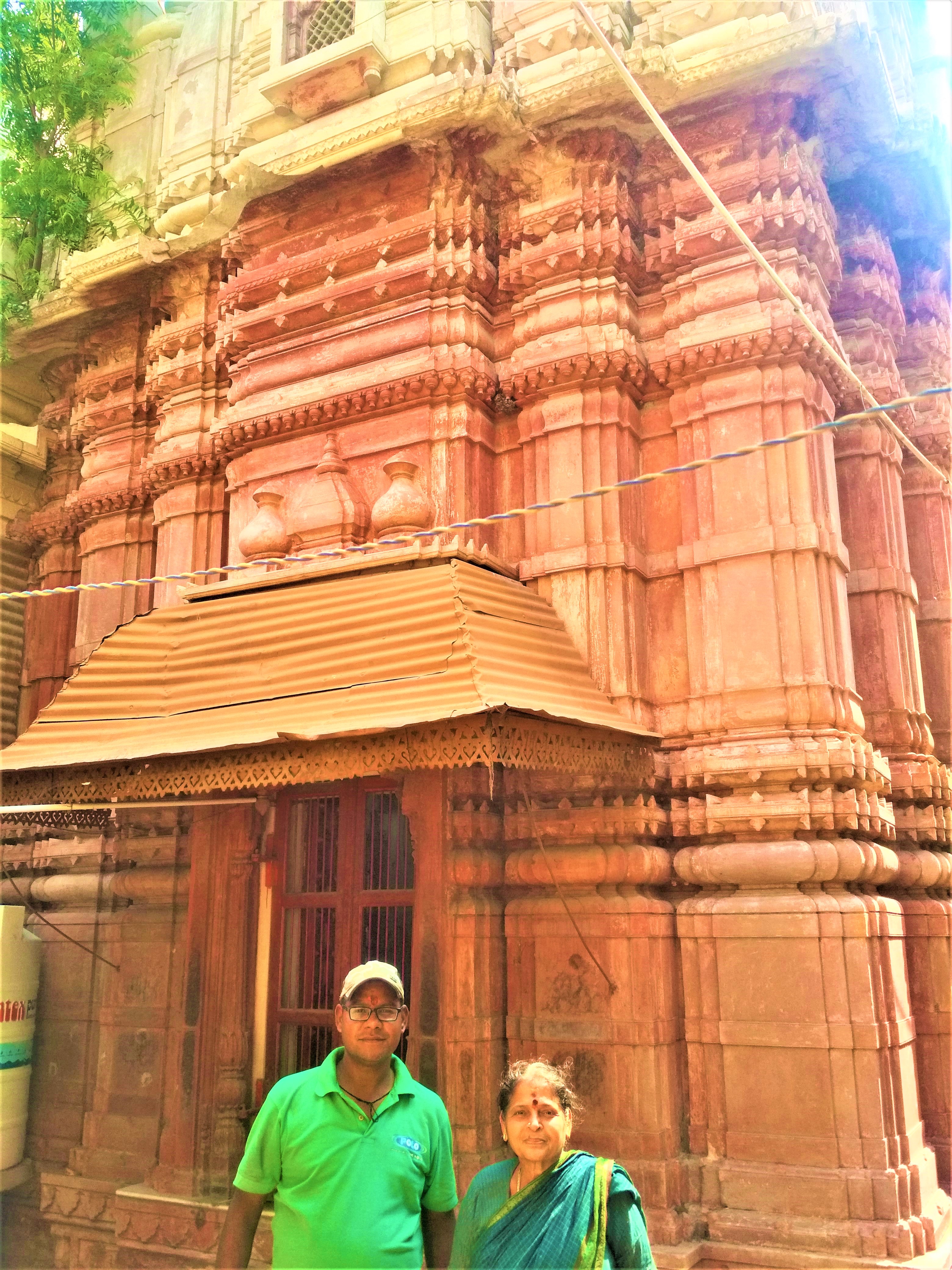 |  |  |
As per legend, in 61st Chapter of Kashi Khand, When Lord Vishnu evicted King Divodasa from his Kingdom he established himself in the form of Adi Keshav at Padodak teerth.
Adi means “Origin” and the word Keshav is a form of Lord Vishnu. This temple is one among the ancient temples of Kashi. It is considered as one of the oldest temples in Varanasi and is probably considered the first temple of Lord Vishnu in Kashi. The architecture of this temple is the most attractive one and is different from the temples constructed in Indian Style. In this temple Adi Keshav – Sangameshwar Linga is also established which is a four faced Linga which is believed to be established by Adi Keshav. According to the beliefs, devotees who worship the Adi Keshav form of Lord Vishnu gets rid of all their sorrows and flourishes success & happiness in life.
Varanasi has been home to numerous Surya-related temples. Predominantly lord Surya is worshipped in following twelve forms in Varanasi Arun Aditya, Drupad Aditya, Ganga Aditya, Keshava Aditya, Kakholkh Aditya, Lolark Aditya, Mayukh Aditya, Sambha Aditya Uttarark Aditya, Vimal Aditya, Vriddh Aditya & Yama Aditya. Probably only city in India where one can find such 12 Aditya Temples.
Lord Vishnu(Adikeshav) told Suryadev that in Varanasi, Lord Shiva is the only deity to be worshipped and Shri Keshav has also got his splendor from Lord Shiva only. By worshipping Lord Shiva, sins of hundreds of births can be washed away. On hearing this from Shri Keshav, Suryadev started performing penance by worshipping Shivalinga by assuming Adikeshav as his Guru. Since then, Lord Aditya is established here and popularly known by the name of Keshav Aditya.It is believed that by worshipping Keshav Aditya, devotees can get rid of all their sins. To Return to INDEX, Click Here. Otherwise Continue
4.0 Char Dham Yatra in Kashi
Char Dhams were established by Adi Shankracharya in four directions of India. These Char Dhams includes Badrinath, Dwarka, Puri and Rameswaram. It is believed that by visiting these Dhams and worshipping deities there, devotees can attain salvation. These Dhams are considered highly sacred and one must visit these Char Dhams once in a lifetime.
In Varanasi, replica of these Char Dhams has been established at different locations. It is believed that by worshipping these Dhams present in Varanasi, devotees can attain same benefits as that obtained by worshipping Char Dhams established across India.
4.1 Badri Narayan Mandir
Badri Narayan Mandir is one of the Char Dhams in Varanasi. Other temples in Char Dham are : Shri Jagannath Ji Temple, Rameshwaram temple & Dwarakadeesh temple.
Badrinarayan temple located at Badri Narayan Ghat of Varanasi is a replica of Badrinarayan Dham situated at Nar-Narayan mountain range in Uttarakhand. Nar-Narayan Teerth is believed to exist in River Ganga that lies near Badri Narayan Ghat. According to a belief, by worshipping Badrinarayan after taking bath in Nar-Narayan Teerth, devotees can obtain same benefits as that from Badrinarayan Dham located in Uttarakhand.
 |  | 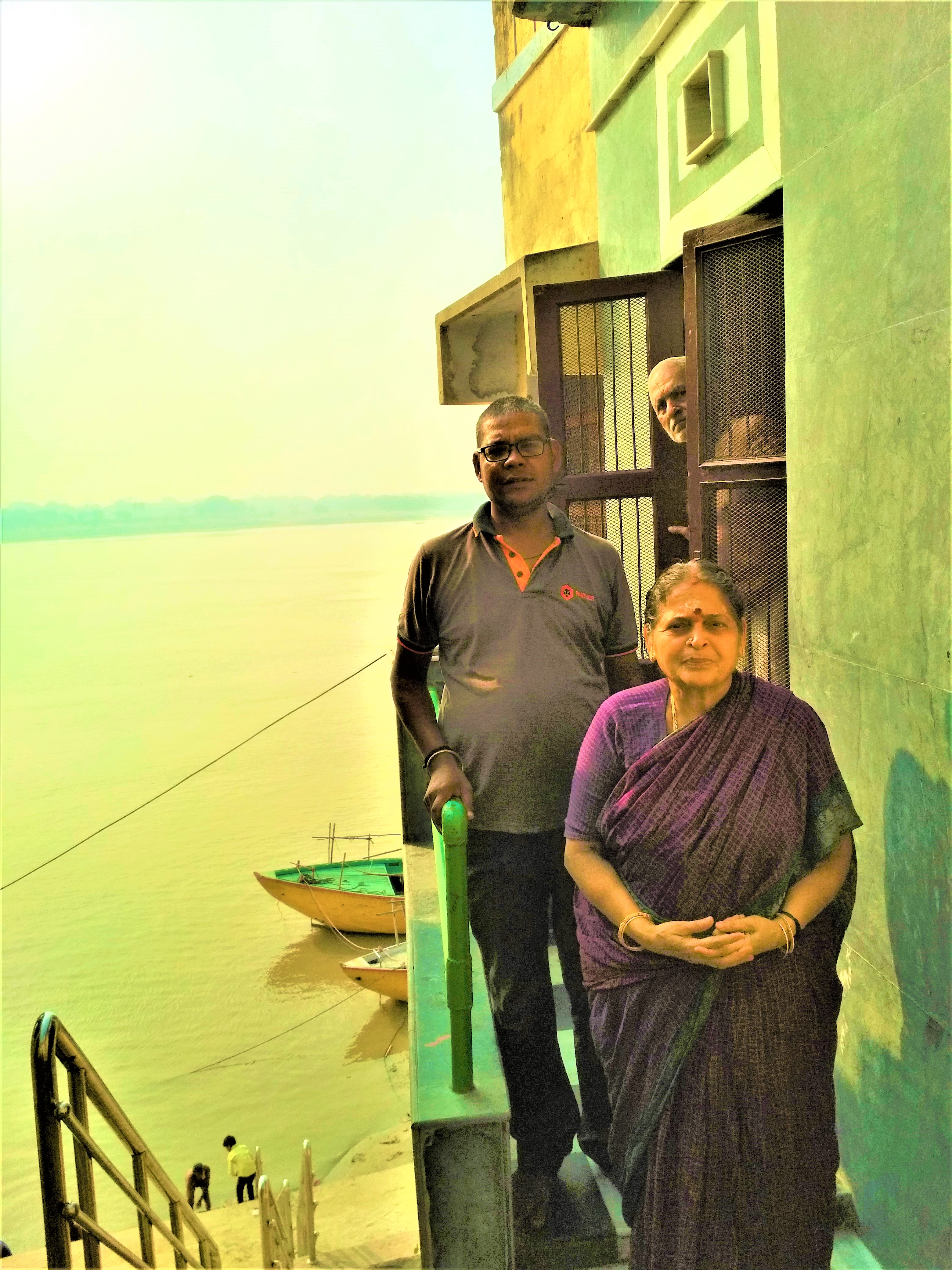 |
Kashi Khand states one Narayan Teerth where Lord Vishnu is available in the form of Nar Narayan. Devotees who worship Nar Narayan will become equivalent to Lord Vishnu. Narayan Teerth is not inexistence now. Nar Narayan (popularly known as Badri Narayan) is located at A.1/72, Badri Narayan Ghat.
On the occasion of full-moon day of Paush (Paush Purnima (December-January), is celebrated here in the honor of Lord Vishnu. Also, on 3rd light-half of Vaishakha (April-May) sacred bath ceremony at this ghat is believed to hold utmost importance.
4.2 Shri Jagannath Ji Temple
Shri Jagannath Ji Temple is located Near Assi Ghat, , Bhelupur, Varanasi, Uttar Pradesh . It is one of the Char Dham temples of Varanasi. Others are : Badri Narayan Temple, Rameshwaram temple & Dwarakadeesh temple.
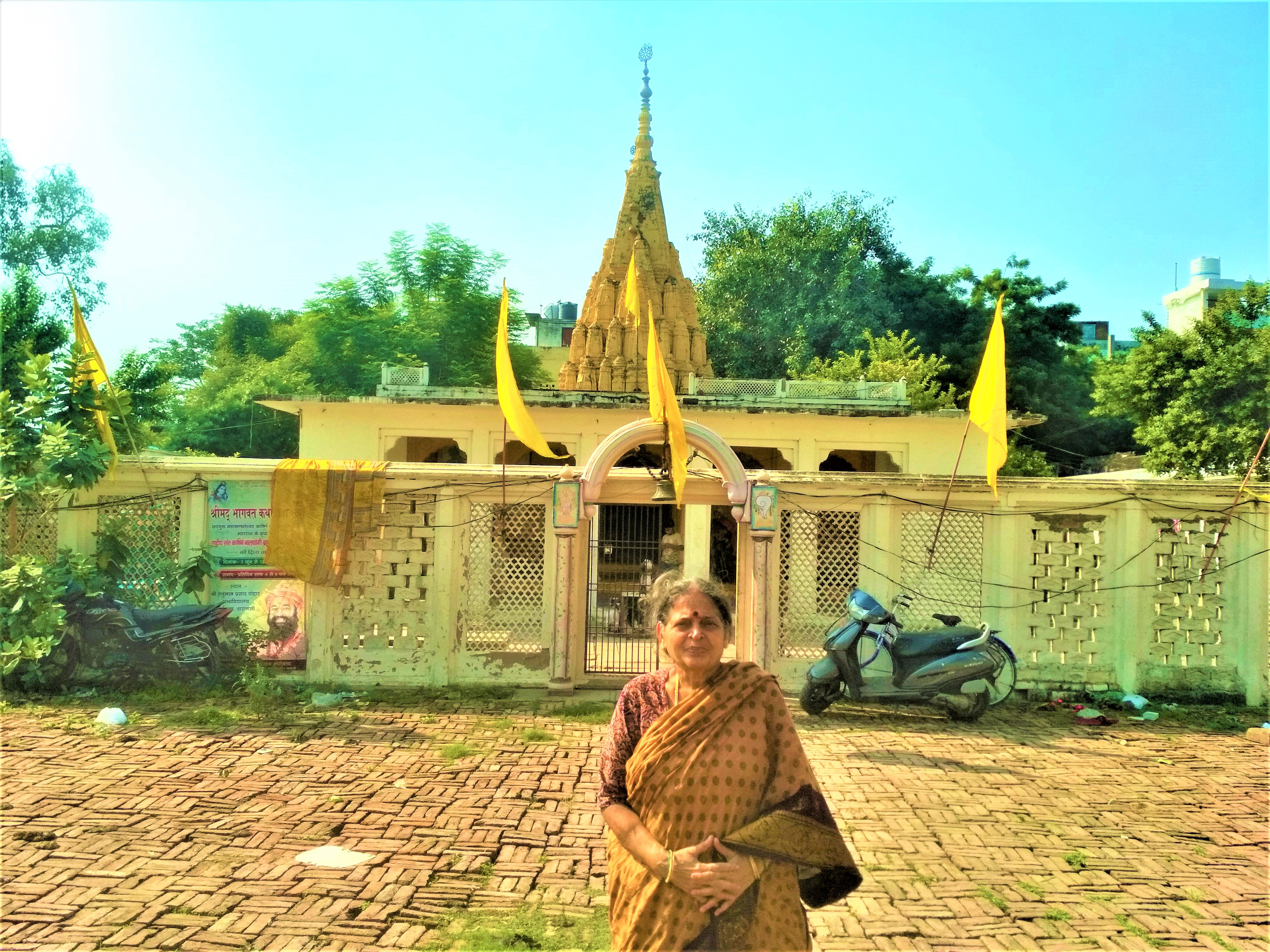 |  |
Jagannath Temple Varanasi overlooks the Asi Ghat and is a replica of Puri Jagannath Temple. The temple dates back to 1802 when two affluent citizens from Bhonsala estate, Visambhar Ram, and Beni Ram constructed it to honor Lord Jagannath. The temple has many resemblances to the original one including idols and architecture. It witnesses traditional worshipping of Lord Jagannath much like the Puri temple. The only difference is in the size of the temple, as it is much smaller in comparison to the Puri temple.
Varanasi, one of the oldest cities in the world, is a desired destination for Hindu pilgrims. The city is home to numerous temples that are frequented by visitors for spiritual luminescence. When in the city, visiting the two-hundred-year-old Jagannath Temple is a must. The Jagannath Temple witnesses a number of rituals on the occasion of Rath yatra festivity when the ‘lakha mela’ (fair that attracts lakhs of people) is organised in the city.
Three idols reside in this temple Lord Jagannath, elder brother Balaram and sister Subhadra. Rituals and procedure of worshipping the deity are similar to that of the Jagannath temple Puri. In four corners of this temples, there are idols of four Vaishnavite divinities namely Krishna, Rama Panchayatana, Kaliyamardan as a form of Hindu God Krishna and Lakshmi-Narayana.
Along with these idols, there is also an image of Prachanda Narasimha, measuring almost four meters high and his devotee Prahlada. The complex of this Jagannath Temple in Varanasi is divided into three sections that are linked through gates. The shape of this temple is rectangular, and height of the main spire is almost sixteen meters. In four corners of this temples, there are figurines of four Vaishnavite divinities namely Krishna, Rama Pancayatana, Kaliyamardan as a form of Krishna and Lakshminarayana.
It is believed that by darshan of this temple located in Varanasi, devotees can obtain same punyafal as that from Jagannath Dham situated in Odisha. Rath Yatra celebrated in this temple during June/ July or Hindi month of Ashadha is a miniature form of the one at organised in Puri. The temple is open from 06.00 A.M. to 12.00 noon and from 03.00 P.M. to 09.00 P.M. Aarties are held in the morning and evening.
4.3 Rameshwaram Temple
Shri Panch Dashnam Juna Akhara is located at Hanumaan Ghat, Varanasi, Uttar Pradesh. Rameshwaram Temple s located at B.4/16, in the courtyard of Sri Dashnam Juna Akhara Hanuman Ghat. . It is one of the Char Dham temples of Varanasi. Others are : Badri Narayan Temple, Shri Jagannath Ji Temple & Dwarakadeesh temple.
 |  |
Hanuman Ghat is situated near Juna Akhara, a famous religious sect in Varanasi. It was earlier known as Rameshwaram Ghat as it is believed that it was built by Lord Rama himself to honour his faithful devotee Lord Hanuman. Lord Hanuman is a god of physical strength; so, the ghat is a favourite destination for bodybuilders and wrestlers. Incidentally, the word akhara also means a court or a special ground, where the wrestlers and bodybuilders perform their exercises and hold competitions.
Hanuman Ghat was also the abode of the renowned saint of Vaishnava sect, Vallabhacharya, a great devotee of Lord Krishna. The ghat houses a temple founded by saint-poet Tulsidas, who wrote the world-famous epic of Ramayana. The ghat also boasts of Sri Kanchi Kamakoti Peetam of Sri Shankaracharya Matha at Varanasi. The Sri Kamakoteeswar Mandir is a grand temple where devotional services are regularly held.
Rameshwaram temple is a replica of Rameshwaram Dham situated at sea shore in Tamil Nadu. It is believed that by darshan of this temple located in Varanasi, devotees can obtain same punyafal as that from Rameshwaram Dham situated in Tamil Nadu.
It is believed that Rameshwar Mahadev Teerthadham was established by Lord Shriram, Bharat, Shatrugan, Lakshman and Hanuman. Rameshwaram shivlinga along with Someshwar, Agneshwar, Rachabhishwar Nahuseshwar, Bharateshwar, Lakshmanoshwar, Shastrudheshwar, Dev Panchayat Ling (16 Shivalinga together) are established in the temple premises.
Rameshwaram is a place of religious importance in Kashi’s heritage series and it is the third level of Panchkoshi Parikrama of many devotees who visit here from the corners of the country in order to fulfill their wishes.
Temple remains open for worship from 06.00 a.m. to 12.00 Noon and from 05.00 p.m. to 09.00 p.m. Shivratri Mela, Lota-Bhanta Mela are prominent festivals held at the Rameshwaram Temple premises from time to time.
4.4 Sri Dwarikadish Mandir
Sri Dwarikadish Mandir is located at Shakul Dhara Pokhra Varanasi., Uttar Pradesh .It is one of the Char Dham temples of Varanasi. Others are : Badri Narayan Temple, Shri Jagannath Ji Temple & Rameshwaram Temple.
 |  |
is a replica of Dwarkadheesh Dham situated at sea shore in Dwarka of Gujarat.
It is believed that by darshan at this temple located in Varanasi, devotees can obtain same punyafal as that from Dwarkadheesh Dham situated in Gujarat.There is a big water pond in front of the temple and Shree Maa Lakshmi Ji Ka Mandir nearby. To Return to INDEX, Click Here. Otherwise Continue
5.0 Other Vishnu Temples
5.1 UDUPI SHRI KRISHNA MADHWA Temple

UDUPI SHRI KRISHNA MADHWA Temple is located near Assi ghat, Varanasi, Uttar Pradesh . It houses a small beautiful Udupi Krishna temple and a few rooms for Yatris to stay. Many Satsang pravachans are held in the temple and adjoining premises.
5.2 Shri Satynarayan Tulsi Manas Mandir
Shri Satynarayan Tulsi Manas Mandir is located at Anandbagh, Bhelupur, Varanasi, Uttar Pradesh . Tulsi Manas Mandir is one of the most famous temples in the holy city of Varanasi. This temple has great historical and cultural importance in Hinduism since the ancient Hindu epic Ramcharitmanas was originally written at this place by poet-saint, Goswami Tulsidas in the 16th century
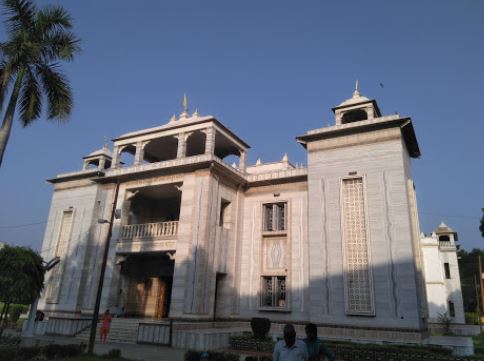 |  | 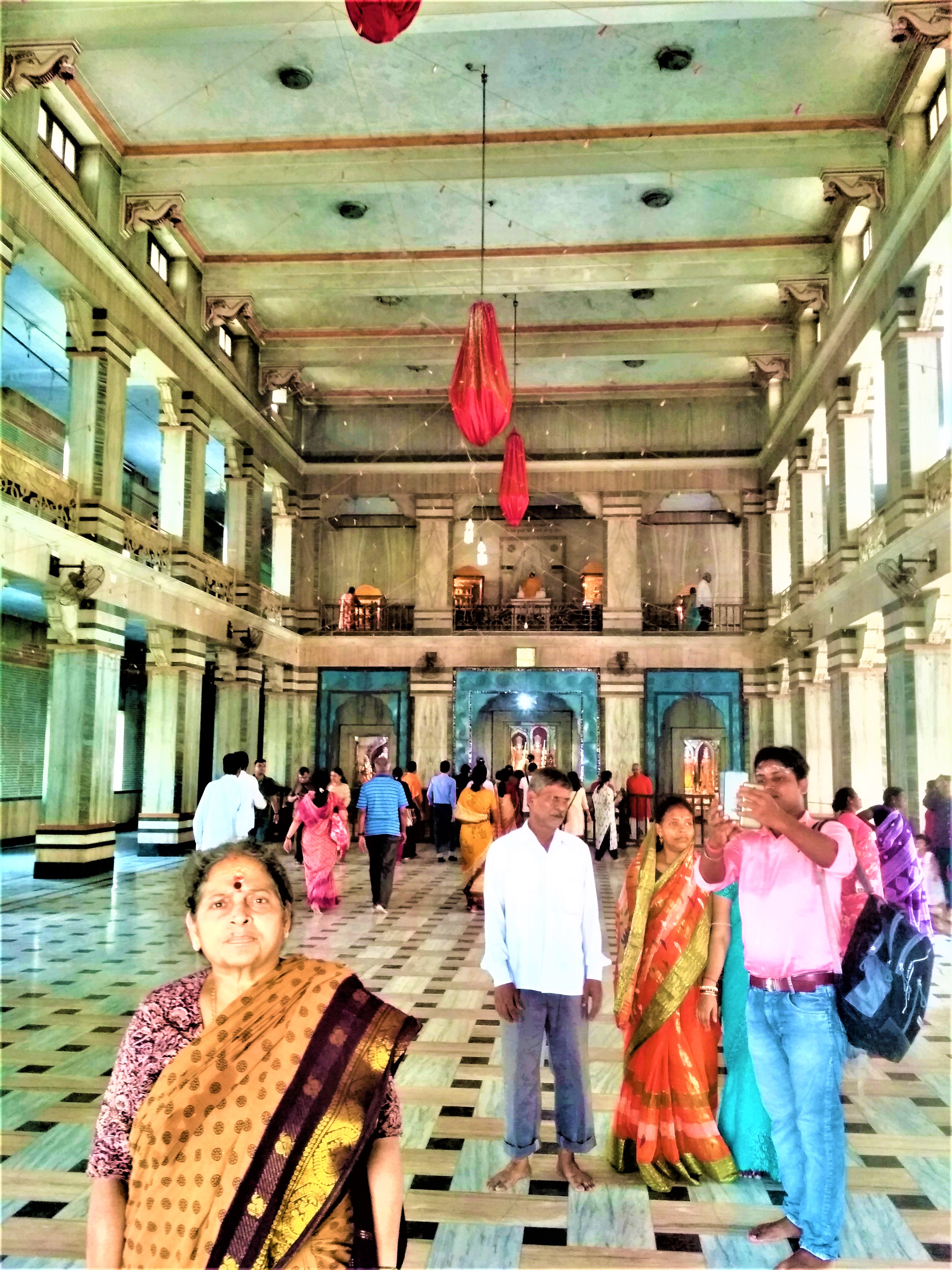 |  |
Great epic, Ramayan was written in Sanskrit language by Valmiki Rishi between 500 and 100 BC. Being in Sanskrit language, this epic was not understood by masses. In the 16th century, Goswami Tulsidas wrote the Ramayan in Awadhi dialect of Hindi language and the Awadhi version was called Ramcharitmanas (meaning Lake of the deeds of Rama.
The oldest city of religion, culture, education, faith, civilization, cultural nationalism, Kashi is also called the city of temples. Apart from Kashi Vishwanath, there are thousands of temples in the city. Any visitor who comes here is lost seeing the structure here.
Durgakund is located seven km away from Varanasi Cantt railway station and is situated near the picturesque Tulsi Manas Temple of Kashi. All the walls of this temple are adorned with the couplets and four-footers of Ramcharitmanas
Tulsi Manas Temple is one of the most beautiful temples in the modern temples of Kashi. This temple is a symbol of peace. Upon entering here, the mind gets peace. It is said that Tulsidas Ji composed Ramcharitmanas at this place. This is the reason why it is called Tulsi Manas Temple. Here the musical Ramcharitmanas Sankirtan resonates in a melodious voice.
According to local residents, there used to be a small temple here earlier. In 1964, Seth Ratanlal Sureka, a businessman from Calcutta, built a grand temple with white marble, which was inaugurated by the then President of India, Dr. Sarvepalli Radhakrishnan.
In the midst of this temple, the beautiful idols of Lord Shri Ram, Mother Sita, Lakshmanji and Hanuman are decorated. These statues are movable. Also, there is a temple of Mata Annapurna and Shivji on one side and Lord Satyanarayana on the other side.
On the second floor of this temple automated Sriram and Krishnalila are displayed. The statue of Tulsidas is also situated on this floor. Unlike the other crowded temples of Kashi, the serene atmosphere of this temple makes a distinct impact.
5.3 Shree Sanatan Gaudiya Matt
Shree Sanatan Gaudiya Matt is located at Bhelupur, Varanasi, Uttar Pradesh
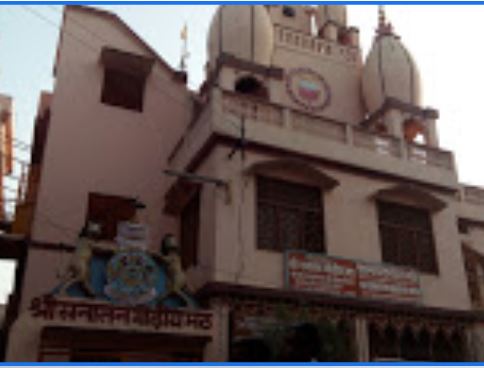 | 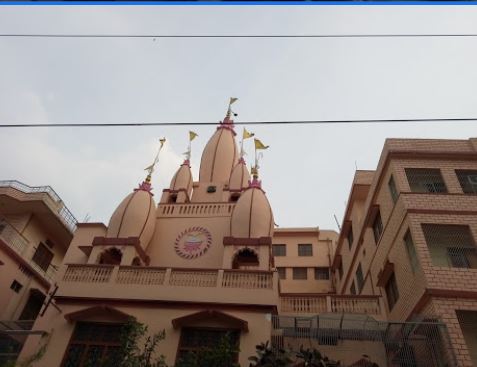 |
Srila Prabhupad established “Sri Sanatan Gaudiya Math” in a rental house of Kashidham in the year 1925. On 3rd December, 1987 with divine grace of Sri Acharyapad the holy entrance ceremony of 82 feet long temple was celebrated on the occasion of Srimad Bhagabat Gita Jubilee celebration.
The Gaudiya Mutt also has several rooms where Yatris can stay on payment basis. Tel: 2275-952 STD 0542 Phone:-9450546283 Must have darshan of beautiful Radha Krishna
5.4 Shri Swami Narayan Mandir
Shri Swami Narayan Mandir, is located at Machodari, Ghasi Tola, Varanasi, Uttar Pradesh
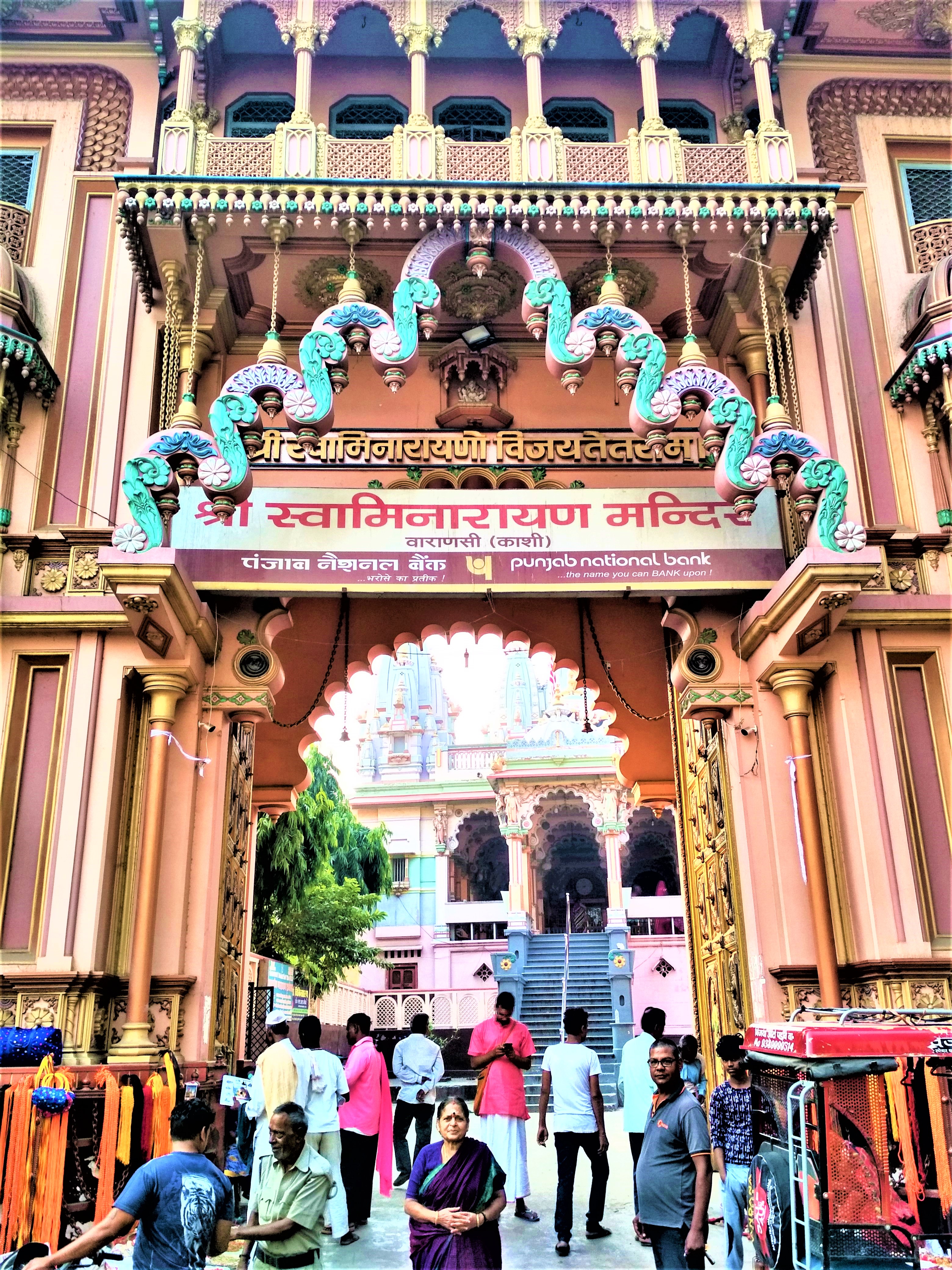 | 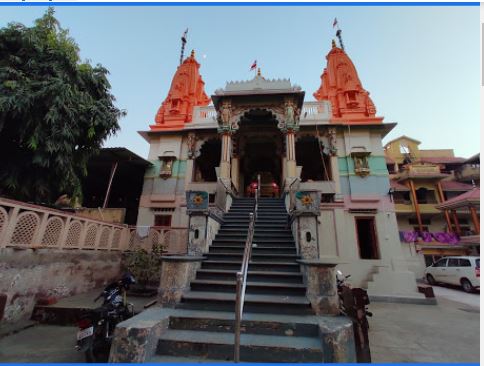 | 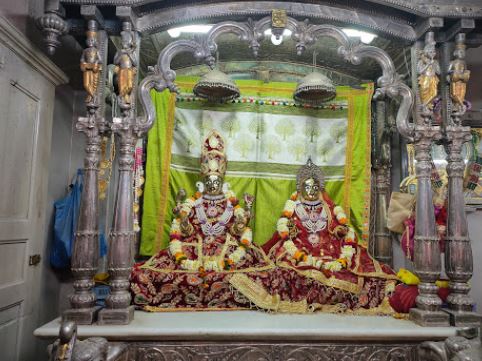 |
This Mandir comes under the NarNarayan Dev Gadi The Naranarāyan Dēv Gadī, named after NarNarayan Dev, is one of the two Gadis (seats) that together form the Swaminarayan Sampraday. Its headquarter is at the Shri Swaminarayan Mandir, Ahmedabad and controls the Uttar Vibhag. The Acharya of the Gadi is Acharya Shree Koshalendraprasadji Maharaj.
Shri Swami Narayan Mandir has lot of accomadation for yatris at reasonable prices.
5.5 Madhusudan Temple
Madhusudan Temple is located near Kameshwar Mahadev Temple
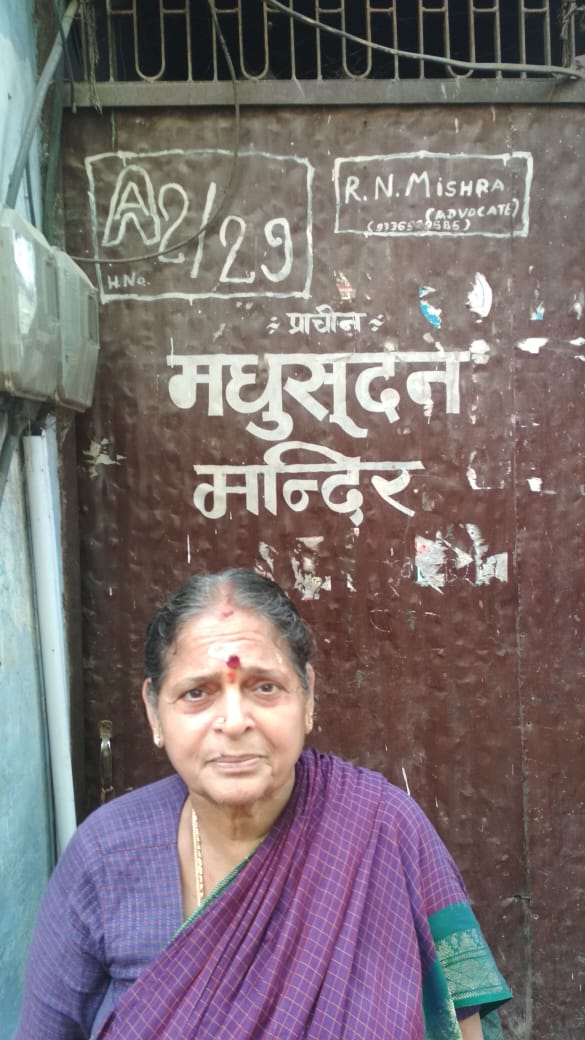 | 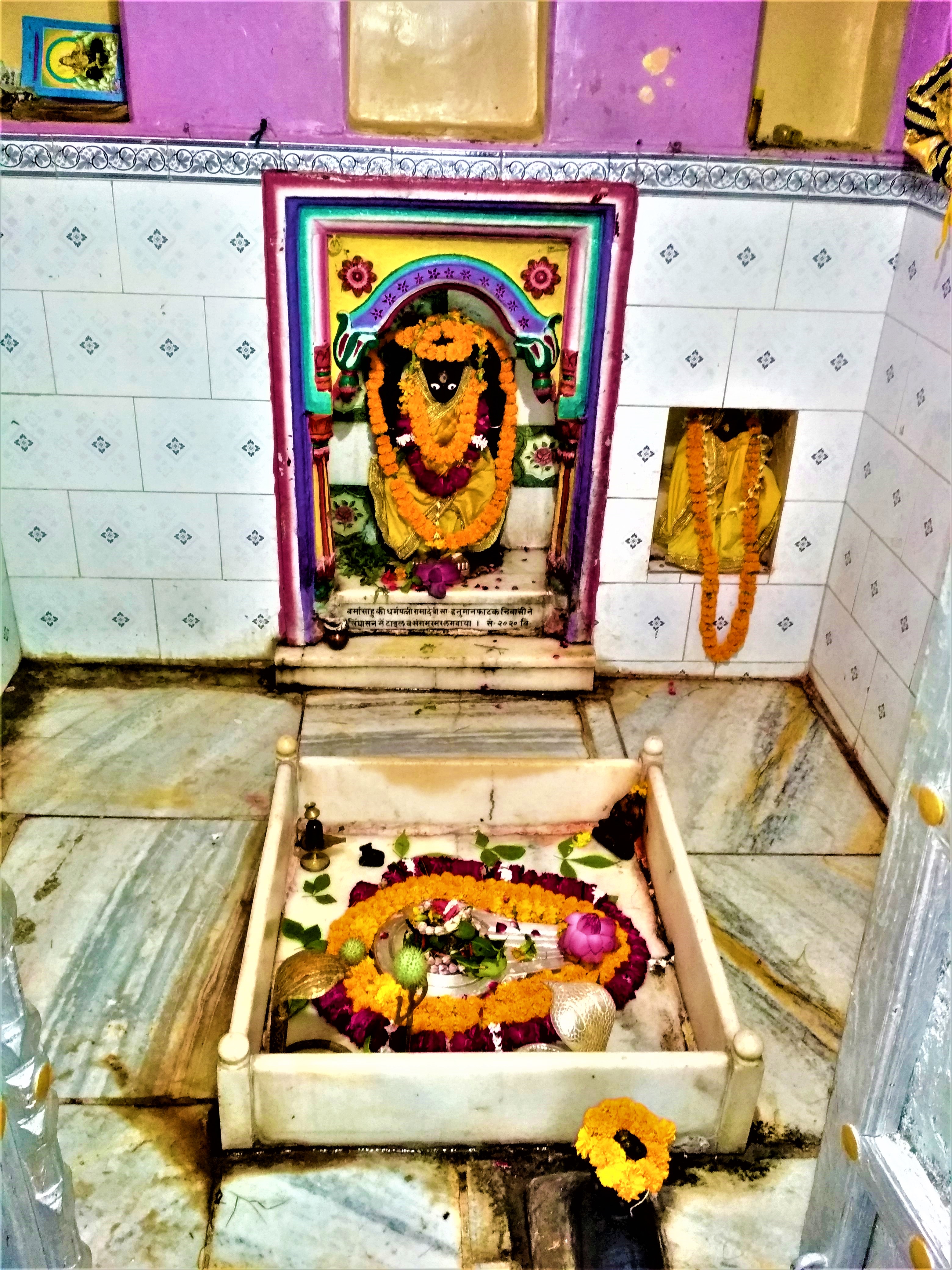 |
Madhusudan Temple is located near TRILOCHAN MAHADEV TEMPLE, , at Ghasi Tola, Varanasi, Uttar Pradesh The temple ios quite small and indiscreet a narrow path from the small road in which it is located. However it is very ancient Vishnu temple which one must visit and have darshan. To Return to INDEX, Click Here. Otherwise Continue

9 thoughts on “Dwadasa Aditya & Vishnu Temples of Varanasi -Top 100 Varanasi Temples – Part 4 of 5 ”